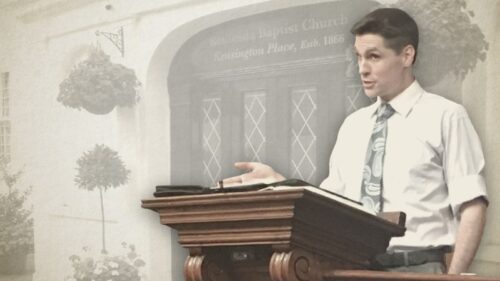14 Israel And The Church
A Summary Of The Teaching Video
Some of the points I cover in this teaching video:
I continue to deal with the controversial matter of the definition and distinctions between the ELECT, ISRAEL and the CHURCH. For this study, I explain the meaning and origin of the CHURCH, showing how it differs from the terms ELECT and ISRAEL. Opportunity is taken to speak also on the subjects of a closed/opened Communion Table and the plural eldership question.
Jared Smith, Muntinlupa, PH (10/02/2023)
An Outline Of The Teaching Video
Defining The Terms
The Elect—Those Persons Set Apart As Objects Of God’s Special Love From Eternity, Under The Terms And Promises Of The Covenant Of Redemption
Israel—The Jewish People As A Nation, Under The Terms And Promises Of The Mosaic Covenant
The Church—A Congregation Of Baptized Believers Covenanted To Follow The Commands Of Christ
Popular Views On The Meaning And Nature Of The Church
The Views Of Dispensationalism And Reformed Teachings
The Reason I Disagree With The Views Of Dispensationalism And Reformed Teachings
My View On The Meaning And Nature Of The Church
The Framework Of Sovereign Grace As It Relates To The Elect And The Non-Elect
To Write The Same Things To You, To Me Indeed Is Not Grievous, But For You It Is Safe.
Election And Sovereign Grace—A People Prepared Unto Glory
Reprobation And Sovereign Justice—A People Fitted To Destruction
The Elect And Non-Elect Are Brought Into The World In An Unregenerate Condition—Conceived In Sin And Shaped In Iniquity
The Elect And Non-Elect Are Brought Into The World Under The Authority And Subject To The Terms Of The Covenant of Works—Responsible To Perfectly Obey The Heat Law
The Elect Are Experientially Delivered From The Authority And Curse Of The Covenant Of Works, Being Brought Under the Authority Of Blessings Of The Covenant Of Redemption, When They Are Regenerated By The Effectual Power Of The Holy Spirit
It Is In This Way All Of God’s Elect People Throughout The Course Of History Have Been Brought Into Relationship With God—On The Basis Of The Regenerating Power Of The Holy Spirit
The Framework Of Sovereign Grace As It Relates To The Church
For The First 4,000 Years Of History, God’s Regenerate People Met Together Within The Local And Visible Communities Of Family Units
The Family Unit And Corporate Worship
The Family Unit And The Jewish People With Their Earthly Covenants—The Tabernacle And Temple Were Not The Divinely Appointed Places For All Of God’s Spiritually Elect People To Meet For Worship And Edification
For The Last 2,000 Years Of History, God’s Regenerate People Meet Together Within The Local And Visible Communities Of Family Units And Congregations/Assemblies
The Meaning Of The Greek Term (Ecclesia) Translated “Church” In The New Testament Scriptures
The Family Unit Is The Prototype Of Christ’s Congregation
Christ Organized His Congregation During His Earthly Ministry
There Were Thirteen Men, Twelve Of Whom Had Made A Profession Of Faith And All Of Whom Had Been Baptized
Christ Organized These Men Into A Congregation
The Congregation Of Christ Was Not Organized On The Day Of Pentecost
The Congregation Of Christ Had Been Clearly Organized During His Earthly Ministry
Some Basic Features Of The Congregation Organized By Christ During His Earthly Ministry
A Body Of Baptized Believers Following His Commands
A Membership Of Only Thirteen
The Lord’s Table Was Designed By Christ To Be A Church Ordinance (Closed Communion), Around Which The Congregation Maintained Discipline
The Church Is Designed To Be Few In Number (Reflective Of The Family Unit)—Large Churches Should Multiply Into Smaller Churches Within The Community
Each Local And Visible Church Is Recognized As “The Church Of Christ”—An Autonomous, Local And Visible Congregation Of Baptized Believers Covenanted To Follow The Commands Of Christ
There Are Four Divinely Appointed Institutions Throughout The Course Of History—The Family Unit And The Congregation Of Christ Continues Today
A Side Point—The Jewish Synagogue Is Not A Prototype Of The Church, Especially In Terms Of Plural Elderships
Two Common Errors Among Reformed Believers As It Relates To The Church And God’s Elect People
The Term Church Is Used As A Synonymous Word For All Of God’s Elect People Universally Throughout The Ages
The Term Church Is Understood To Mean In The New Testament What The Word Israel Means In The Old Testament
A Final Word
An Automated Transcript Of The Teaching Video
I’d like to welcome you back for another study in the Word of God. We continue our series of studies on the biblical covenants. And if you remember from our previous study, I began to tackle a subject which is shrouded with confusion. It’s the meaning and distinctions of three biblical terms—the elect, Israel and the church. I’d like to speak to you in this study on the subject of Israel and the church.
Defining The Terms
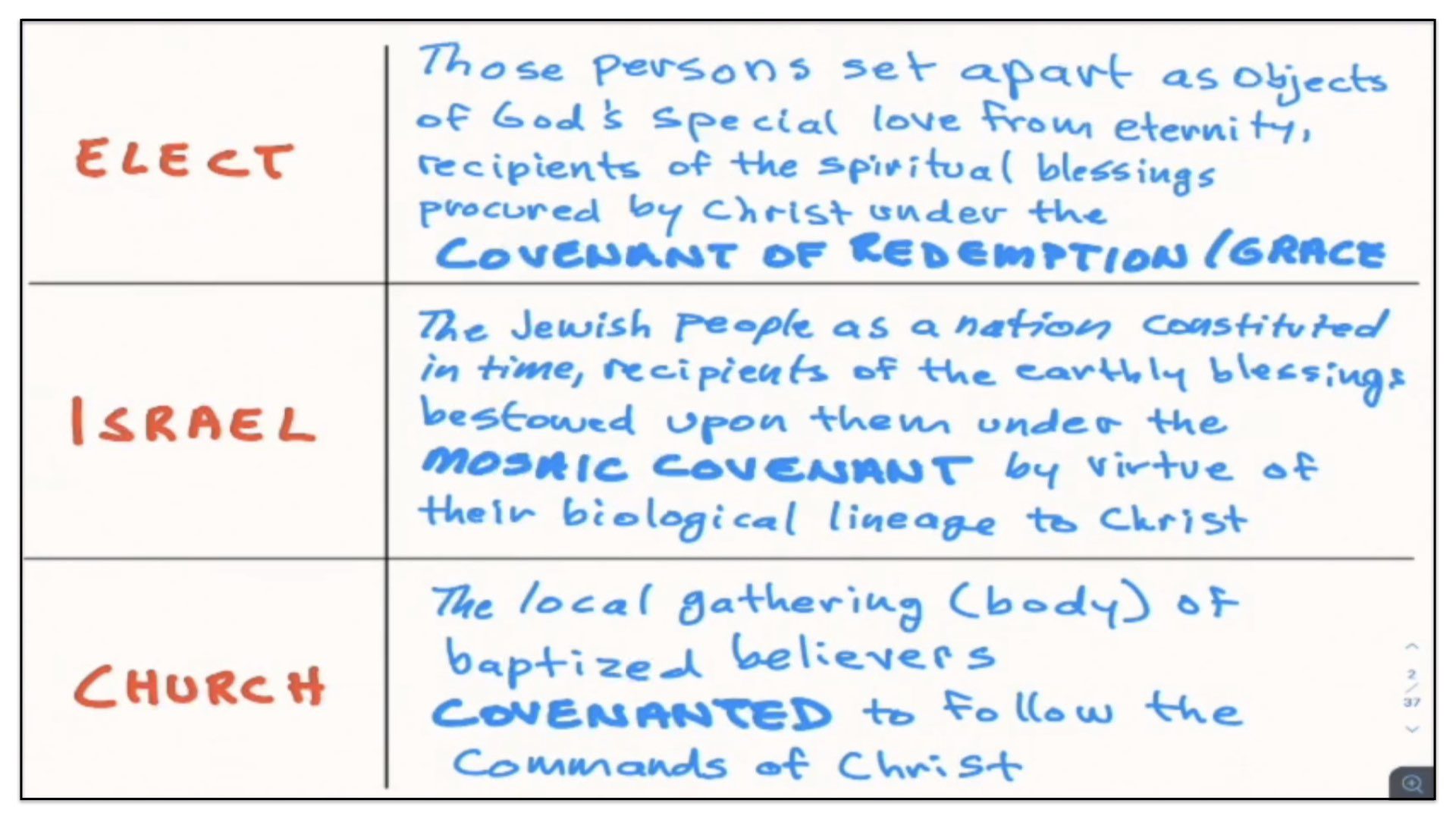
Now, let me begin by reminding you on how I define these three terms. I believe the terms can be defined in the following ways.
The Elect—Those Persons Set Apart As Objects Of God’s Special Love From Eternity, Under The Terms And Promises Of The Covenant Of Redemption
Beginning with the term elect, and of course in the scriptures, this term can be used for a number of different things. But with reference to how we distinguish one group, which are identified as the elect from Israel and the church, this is how I believe should distinguish them. The elect is a reference to those persons set apart as objects of God’s special love from eternity, recipients of the spiritual blessings procured by Christ under the Covenant of Redemption, otherwise known as the Covenant of Grace. This of course refers to all persons throughout the course of history, from Adam and Eve all the way through to the last persons that will be brought into existence. Every one of those persons who have been chosen by the Father and Redeemed by the Son will be regenerated, sanctified by the Holy Spirit. And you see, it’s in this way God has only one spiritually elect people with a single redemptive plan of salvation for them. That’s what I mean when I refer to the elect in this context.
Israel—The Jewish People As A Nation, Under The Terms And Promises Of The Mosaic Covenant
When we come to the subject of Israel, Israel refers to the Jewish people as a nation constituted in time, recipients of the earthly blessings bestowed upon them under the Mosaic Covenant by virtue of their biological lineage to Christ. Now, you’ll know from our previous studies, the nation of Israel came into existence around 2,500 years after the beginning of time and ceased to exist in the year 70 AD with the destruction of Jerusalem. This was a physically elect people and distinct from the spiritually elect, which I’ve just referred to—the first of these terms. This physically elect people, Israel, were set apart by God based squarely on their biological lineage to the Messiah. They were special by race, not so much by grace. Now I say grace within a spiritual context of God’s redemptive plan for His chosen people. Now while God bestowed upon Israel many earthly and material blessings, this had absolutely nothing to do with the spiritually elect and God’s redemptive plan of salvation for sinners. This is an important distinction to make between the elect and Israel. The spiritually elect belong under the promises and blessings of the Covenant of Redemption, or the Covenant of Grace, whereas Israel, the physically elect, they belong under the promises and blessings of the Mosaic Covenant. The two are very different groups of people and should never be conflated.
The Church—A Congregation Of Baptized Believers Covenanted To Follow The Commands Of Christ
Well, this then brings us to the church, which I believe is the local gathering, or body, of baptized believers covenanted to follow the commands of Christ. Now by this definition alone you should be able to distinguish for yourself the differences between the terms elect, Israel and the church. However, it’s my job to do the work of explanation, so I wish to share with you my understanding of the meaning of the church and its distinction from Israel—and even from the elect, technically speaking—I’d like to share that understanding with you in this study.
Popular Views On The Meaning And Nature Of The Church
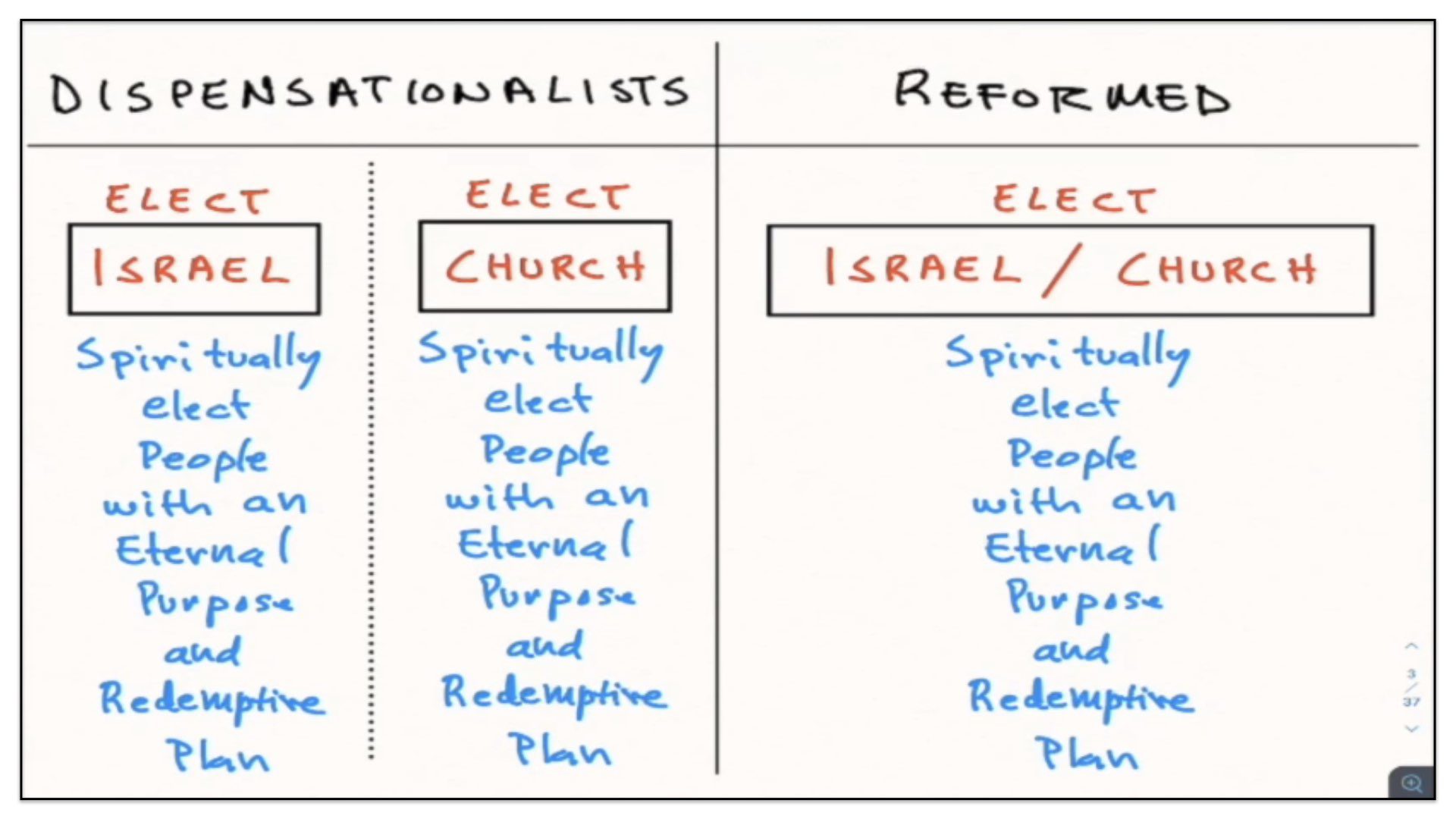
Well in order to go about this, I’d like to begin by highlighting for you a couple of popular views on the subject.
The Views Of Dispensationalism And Reformed Teachings
There’s first, the view of the Dispensationalists. Now if you were to ask a Dispensationalist his or her view on this subject of Israel and the church, he or she will tell you that Israel and the church are two separate entities, both of which are God’s elect people, but each having a distinct redemptive plan from the other. They’re both spiritually elect people with an eternal purpose and redemptive plan. On the other hand, if you were to ask a Reformed believer his or her view on Israel and the church, he or she will tell you that Israel and the church are the same and that God has only one spiritually elect people with an eternal purpose and redemptive plan.
The Reason I Disagree With The Views Of Dispensationalism And Reformed Teachings
Now I don’t believe either of these views accurately convey the teachings of scripture on this matter. Whereas I agree with the Dispensationalist that Israel and the church are two distinct groups, I do not believe God has two spiritually elect people with separate redemptive plans. Likewise, with reference to the reformed teachers or believers, I agree that God has only one spiritually elect people with a single redemptive plan, but I don’t agree that Israel and the church are therefore the same. So you could say, I agree halfway with the Dispensationalists and halfway with the Reformed believers. Just to highlight for you what I believe the errors to be in both of these groups.
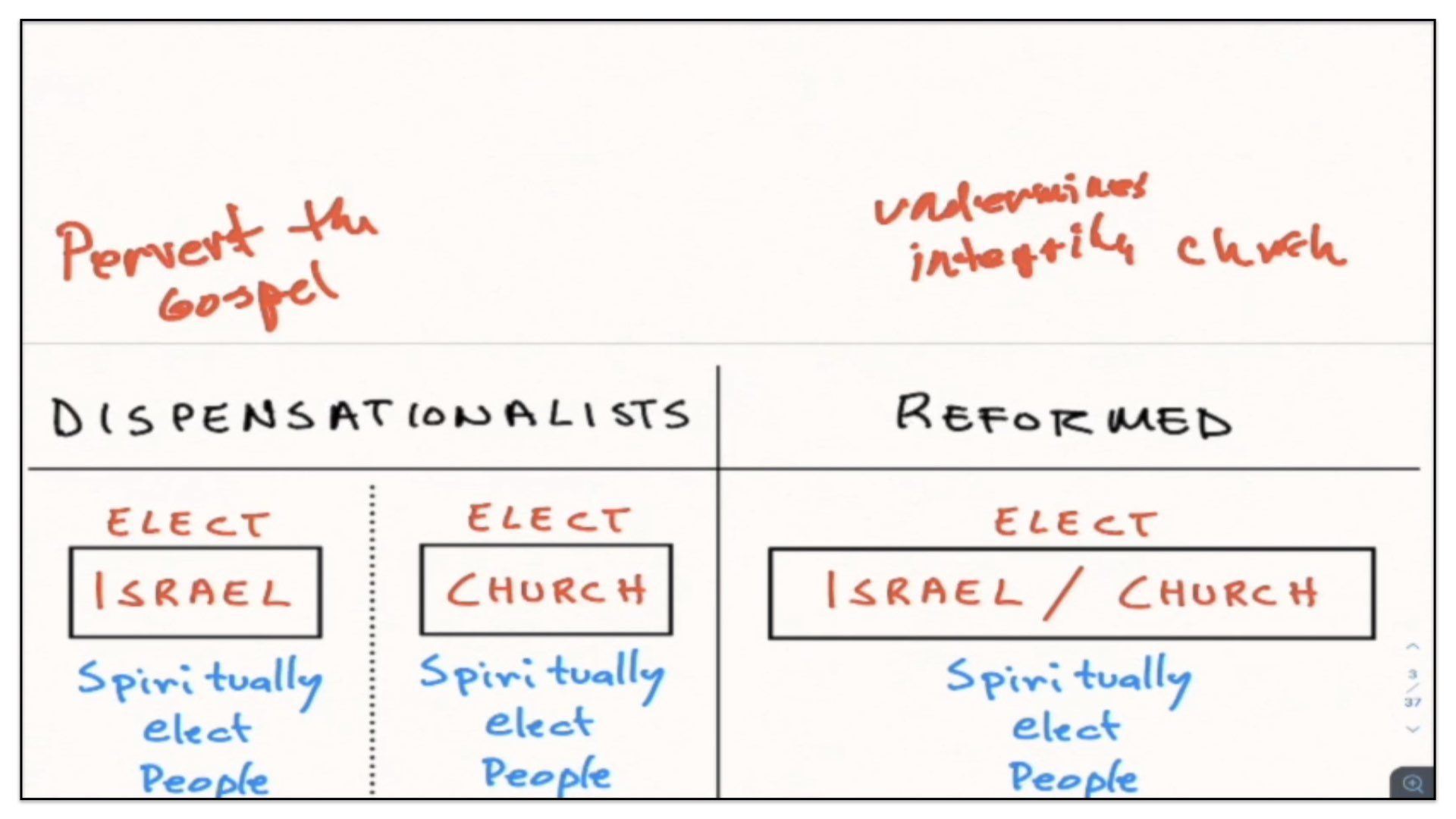
For the Dispensationalists, I believe their error is to pervert the gospel of the Lord Jesus Christ; it’s a perversion of the Gospel of the Lord Jesus Christ. That’s the main error of the Dispensationalists. It perverts the gospel of Christ. Whereas the leading error of the Reformed teachings doesn’t pervert, but rather undermines the integrity of the church of Christ. Dispensationalists pervert the gospel of the Lord Jesus Christ; Reformed believers undermine the integrity of the church of Christ.
My View On The Meaning And Nature Of The Church
Now, it’s my contention that if one is to be a consistent sovereign grace Baptist. Sovereign grace Baptist. One who subscribes to the Doctrines of Grace with a baptistic understanding of the scriptures. If one is to be a consistent sovereign grace Baptist, then I don’t believe he or she can embrace the viewpoint of Dispensationalism or that of the Reformed teachings. Allow me to work this out for you by turning your attention to the subject of the church.
The Framework Of Sovereign Grace As It Relates To The Elect And The Non-Elect
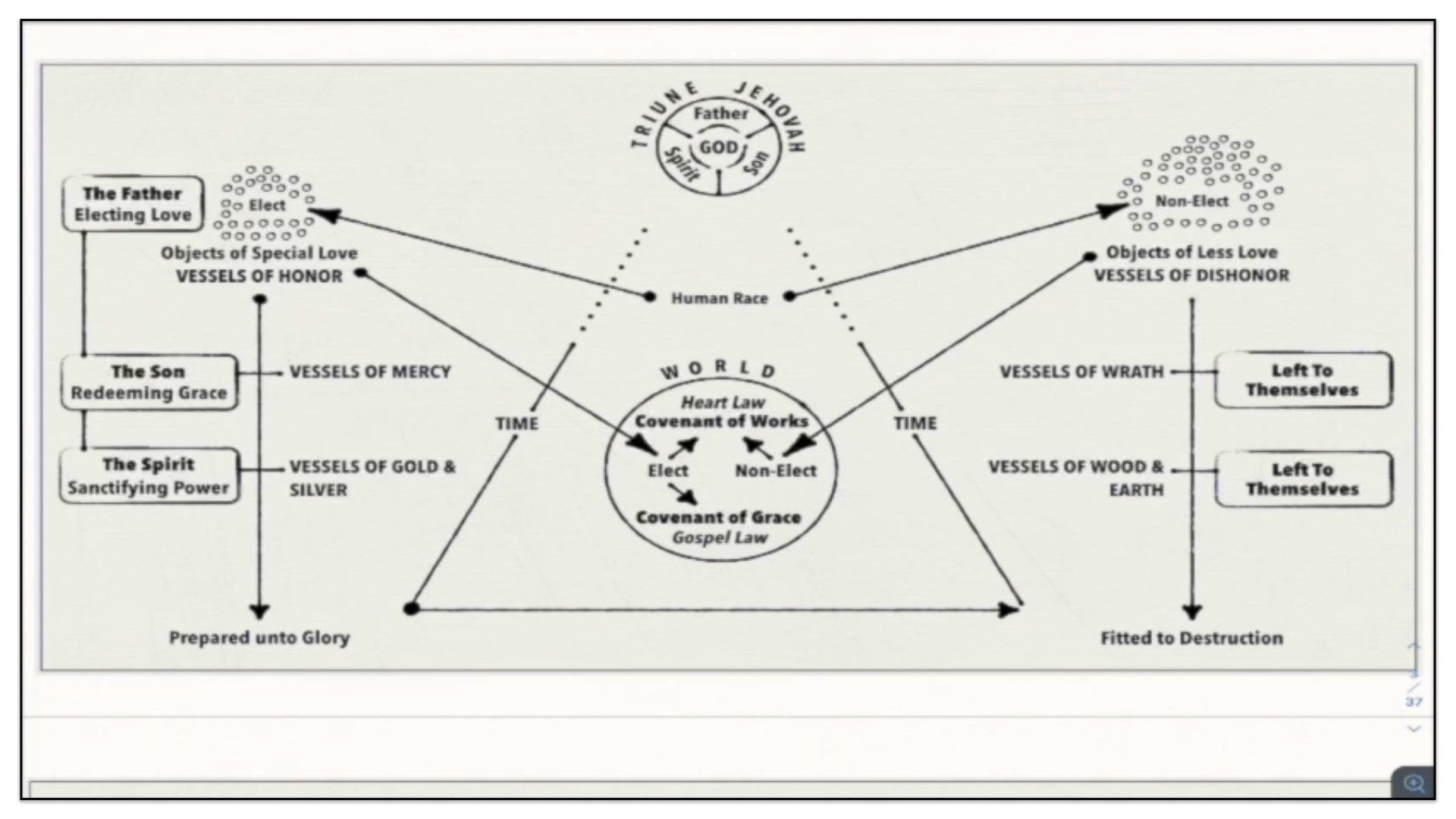
To Write The Same Things To You, To Me Indeed Is Not Grievous, But For You It Is Safe.
The question is, when did the church come into existence? And what exactly is it? To answer these questions within the context of the overarching design of God’s masterplan for the ages, and to that end, I’d like to refer you to the Framework of Sovereign Grace. Now bear with me. I understand that I end up repeating what I’m about to say to you and just about all of my teachings. And I do so for good reason. I often feel that a teacher, what he says, goes over the heads of many who listen to him or in one ear and out the other. Not every listener processes properly the information that’s given and so it’s safe as the Apostle Paul wrote in one of his letters, it’s not a burden for him to repeat himself and it’s safe for those to receive the repetitions. So I say so to you, it’s safe for you to hear these repetitions and it’s not a burden for me to share it. After all, we’re speaking about the gospel of Christ. To that point I would like to draw your attention to the Framework of Sovereign Grace and please watch this. I’m gonna be speaking on the church, but I’m going to lay a backdrop and I’m going to build on the teachings which will bring us ultimately to that subject.
Election And Sovereign Grace—A People Prepared Unto Glory
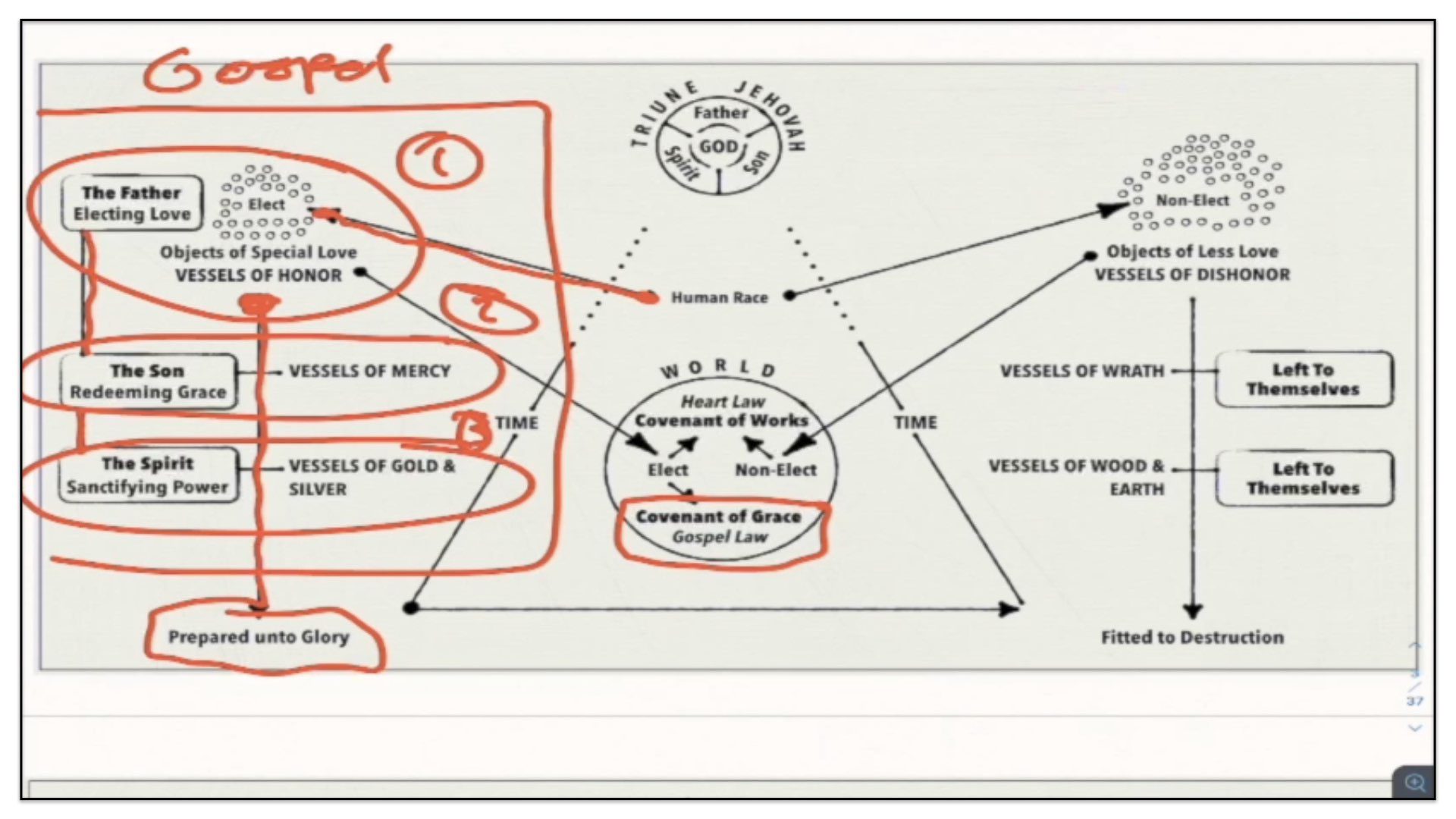
We must begin with God’s elect people—the spiritually elect of God. Those persons set apart by God the Father as objects of special love from eternity. Those persons given by the Father to the Son, appointing the Son to serve as the Mediator and Redeemer for them. These persons given by the Father and the Son to the Holy Spirit, appointing the Holy Spirit to serve as the Sanctifier for the elect. Now this what I’ve presented to you here is called the gospel—the good news of glad tidings. And as you can see, there’s three branches of the gospel—there’s the electing love of God the Father, the redeeming grace of God the Son and the sanctifying power of God the Spirit. And this gospel, also called the Covenant of Redemption or the Covenant of Grace, is that by which God prepares His people unto glory.
Reprobation And Sovereign Justice—A People Fitted To Destruction
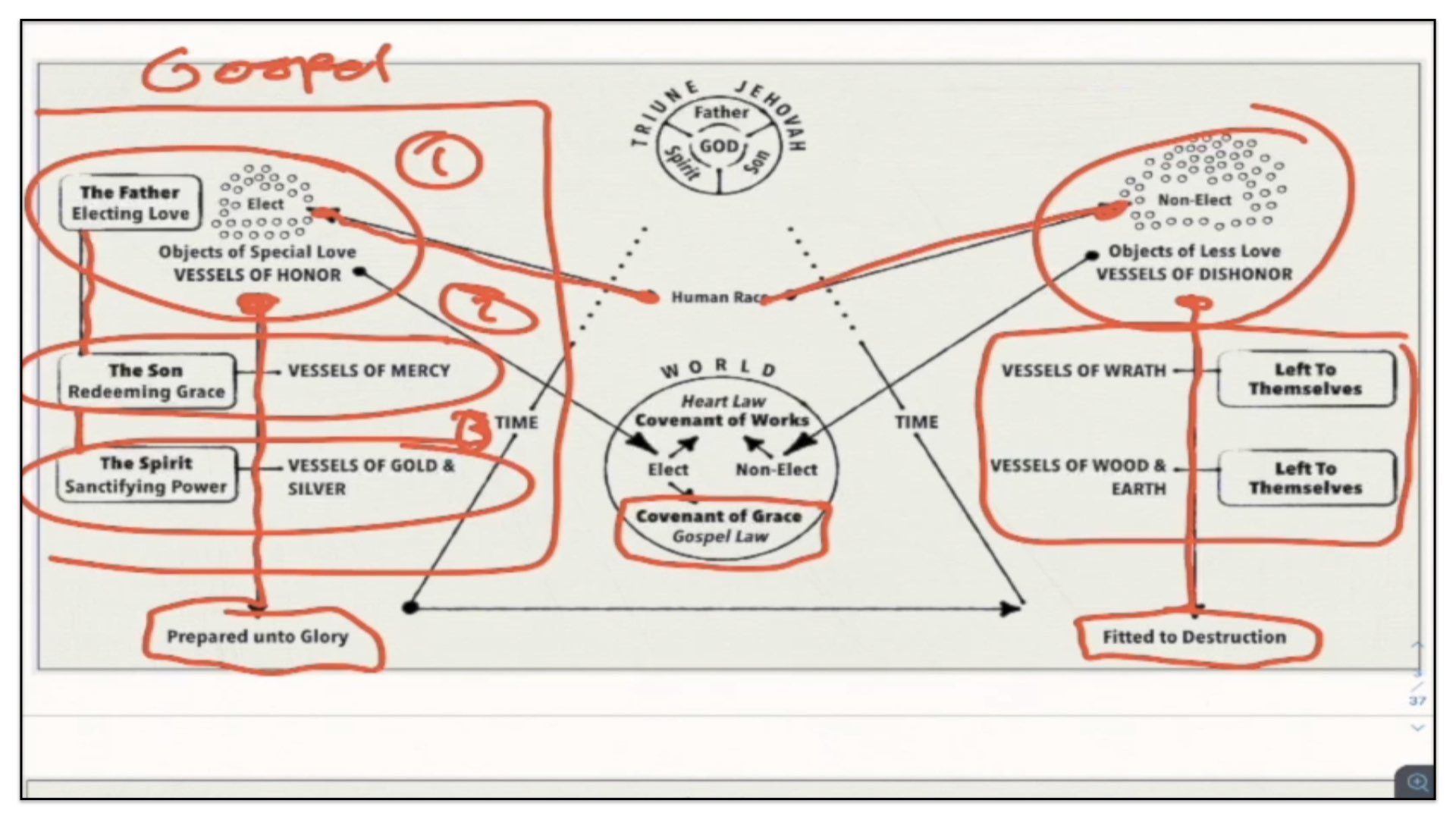
Now, on the other side of this framework we have the non-elect. Those persons set aside as objects of less love. Those persons left to themselves. No, redeeming grace has been procured or promised to them. And these persons are therefore fitted to destruction.
The Elect And Non-Elect Are Brought Into The World In An Unregenerate Condition—Conceived In Sin And Shaped In Iniquity
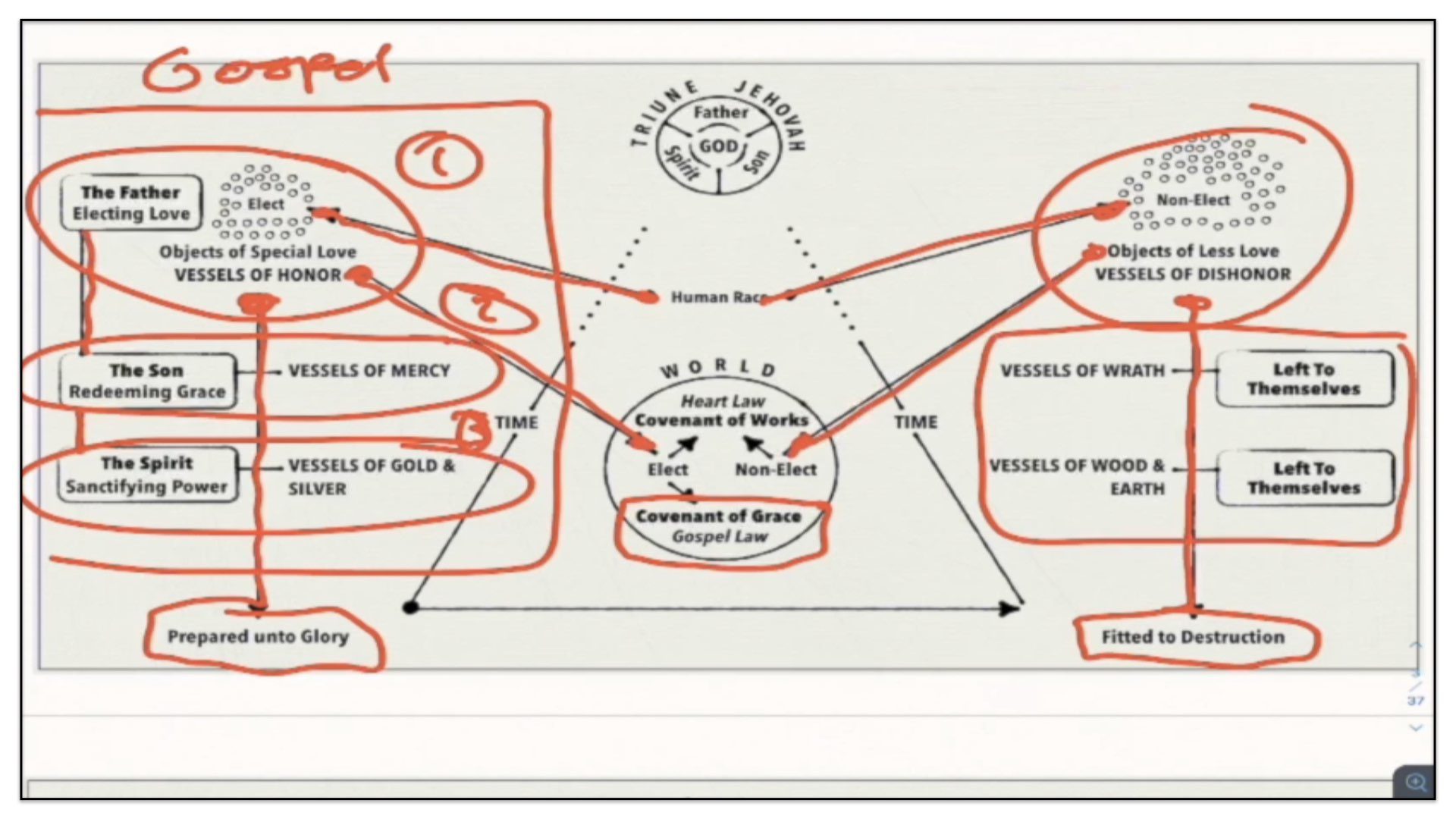
Now throughout the course of history, both groups are brought into the world—the elect and the non-elect. Both groups come into the world conceived and sin and shaped in iniquity, and therefore spiritually dead in trespasses and sins. They are in an unregenerate condition. That is true of the elect and the non-elect.
The Elect And Non-Elect Are Brought Into The World Under The Authority And Subject To The Terms Of The Covenant of Works—Responsible To Perfectly Obey The Heat Law
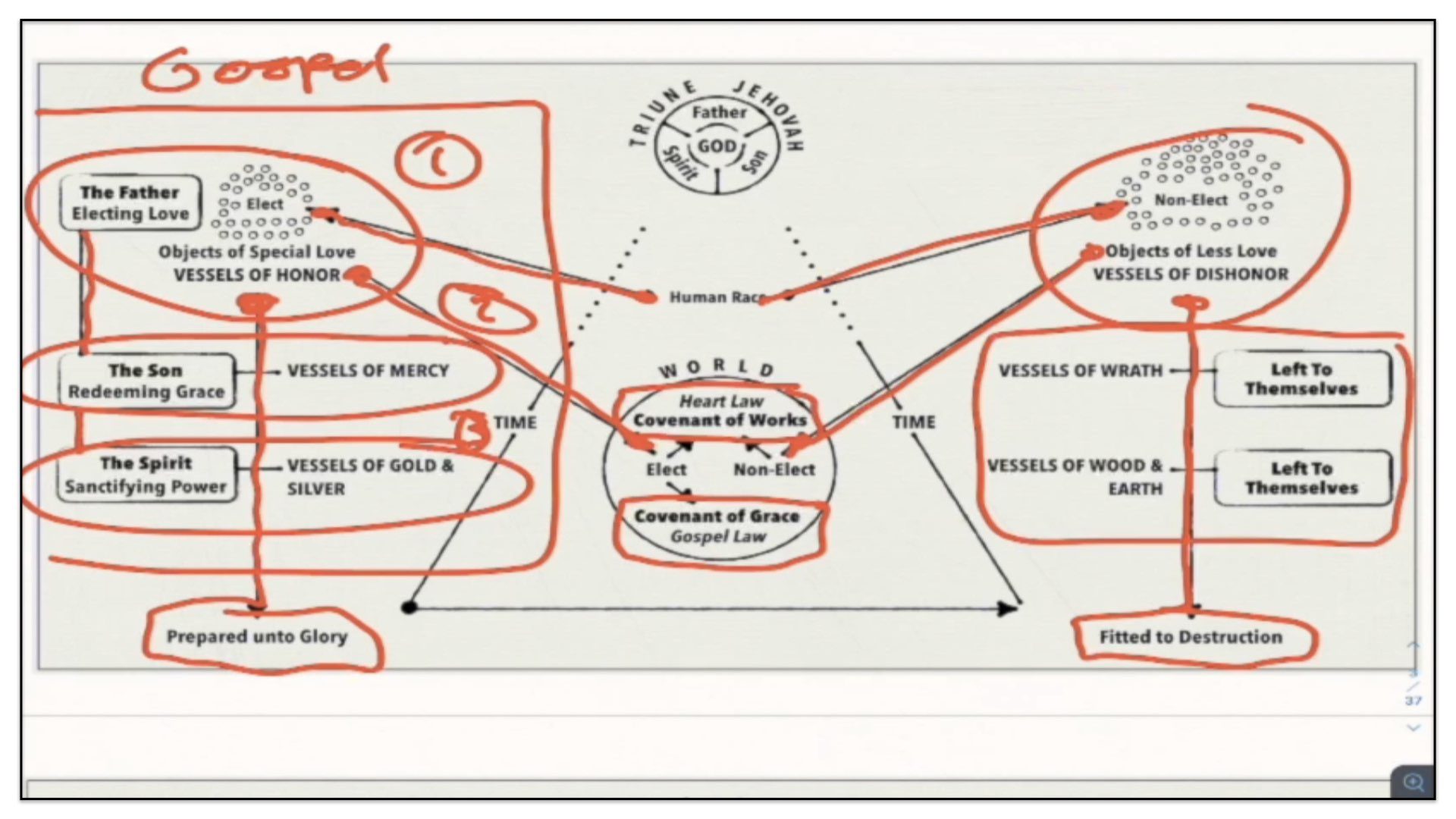
Both groups come into the world under the authority of the Covenant of Works, and therefore they are responsible to perfectly obey the law inscribed upon their hearts. Now, please listen to me, the non-elect and the elect remain in this unregenerate condition, spiritually dead in sin and forever subject to God under the authority of the Covenant of Works, so long as they remain in and unregenerate condition.
The Elect Are Experientially Delivered From The Authority And Curse Of The Covenant Of Works, Being Brought Under the Authority Of Blessings Of The Covenant Of Redemption, When They Are Regenerated By The Effectual Power Of The Holy Spirit
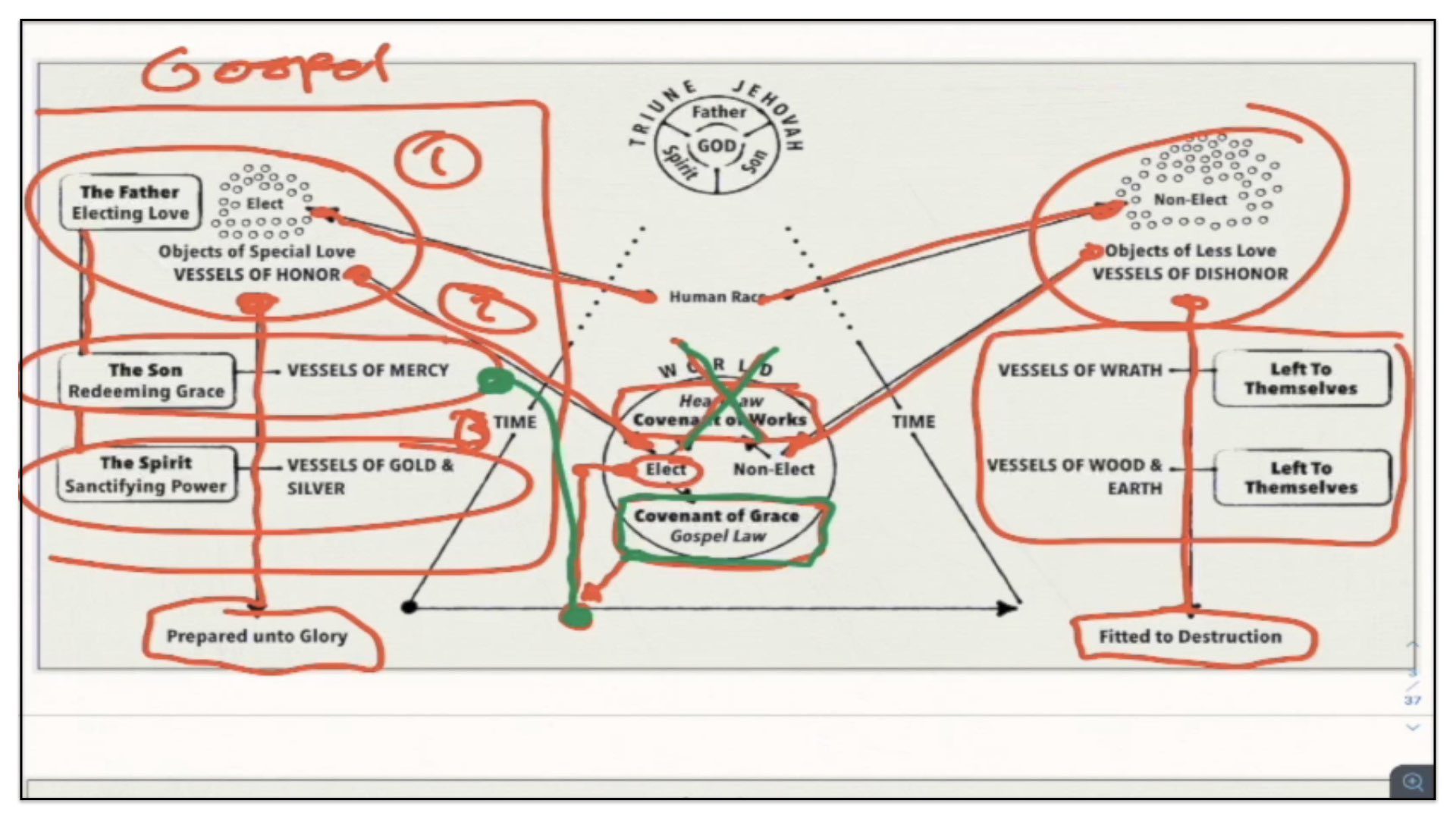
However, when the Spirit of God is pleased to grant to His elect people the experience of a new birth, at that point the elect sinner is delivered from the authority and curse of the Covenant of Works and is experientially brought under the authority and blessings of the Covenant of Grace, or the gospel. You see, it’s at the point of the new birth that the Spirit of God unites the soul—here, I just changed the color pen; watch this—the Spirit of God unites the soul of the elect sinner with the Lord Jesus Christ, whereby the life of Christ flows into the soul, making that soul alive unto God, and by virtue of this spiritual union the virtues of Christ also flow into the soul, enabling the sinner to savingly believe on Christ. And you see, when that occurs, this born again sinner is delivered from the authority and curse of the Covenant of Works and experientially brought under the blessings and authority of the Covenant of Grace.
It Is In This Way All Of God’s Elect People Throughout The Course Of History Have Been Brought Into Relationship With God—On The Basis Of The Regenerating Power Of The Holy Spirit
Now my dear friends, throughout the course of history, it is in this way, and this way alone, that God’s spiritually elect people have been brought into relationship with God. This was true for Adam and Eve. It was true for their sons Abel and Seth. And it is true of all other sinners who have ever been saved by God’s grace. There is one gospel. There is one redemptive plan. There is only one way to experience that redemptive plan, through a new birth, and this is true for all of God’s elect people throughout the ages.
The Framework Of Sovereign Grace As It Relates To The Church
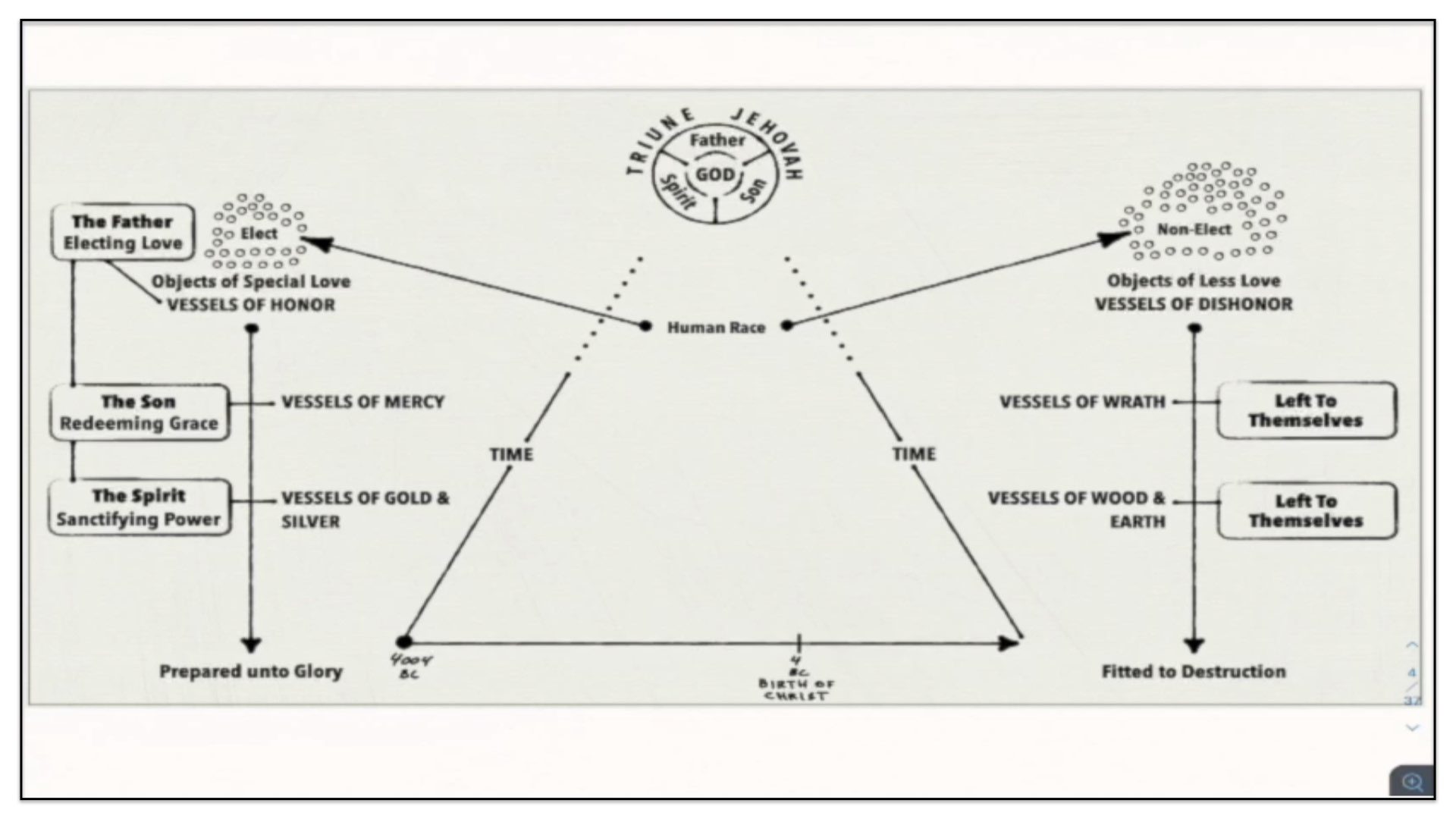
Now with this in mind, keeping that backdrop in your thoughts, let me bring you to the Framework of Sovereign Grace again, but I’m going to build now on the teachings. Remember, we’re coming to the subject of the church and we’re gonna get there shortly. But now let me refer you to this fresh set of notes. Watch this.
For The First 4,000 Years Of History, God’s Regenerate People Met Together Within The Local And Visible Communities Of Family Units
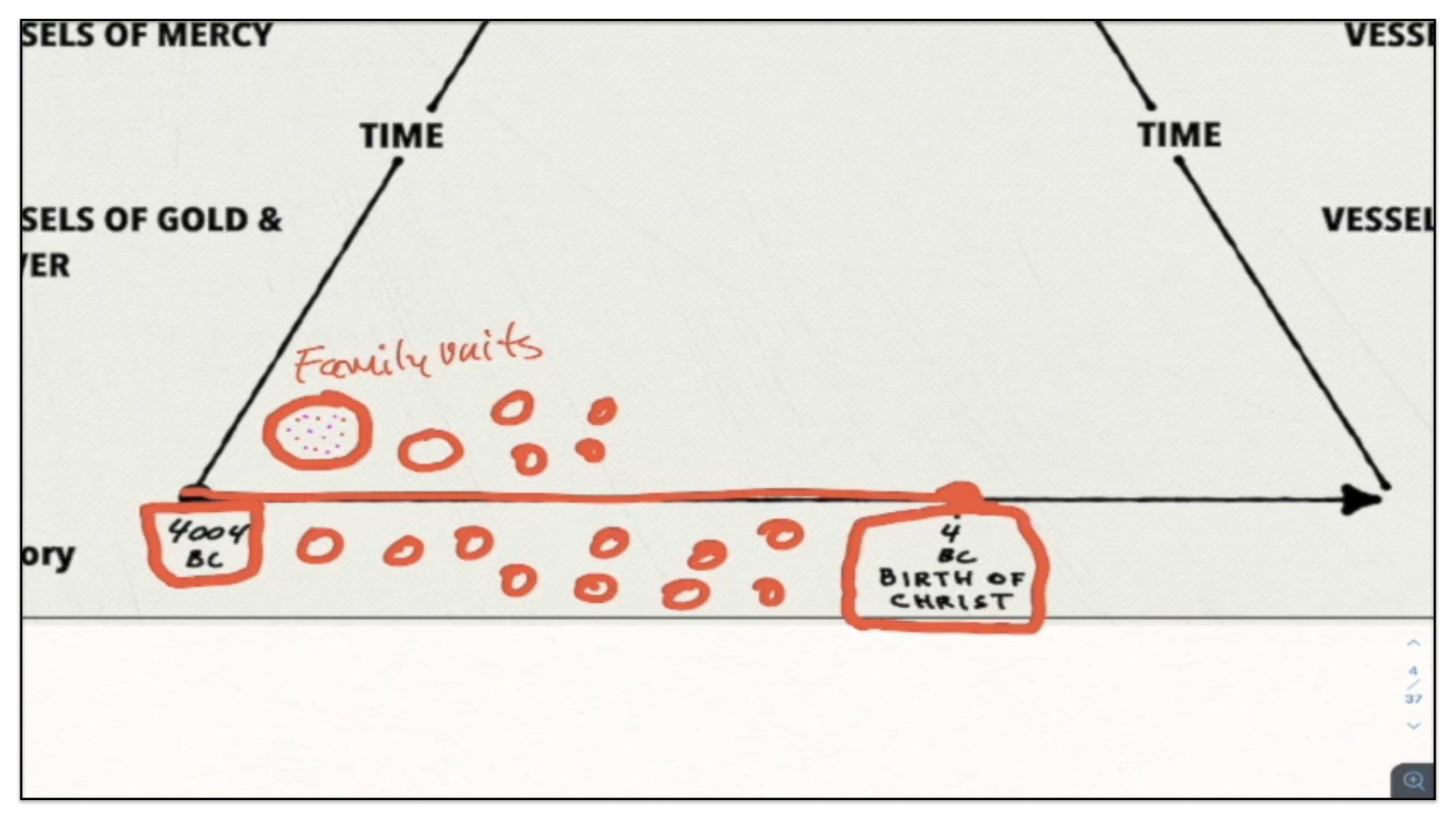
I’m going to zero in on the timeline, beginning with 4004 BC. Let me change the color pen back to red. Beginning with 4004 BC and watch. Coming up to the year 4 BC with the birth of Christ. Now watch this. Prior to the earthly ministry of the Lord Jesus Christ, that is, during the Old Testament era, when God’s elect people were born again, they met together in little communities. These little communities came together for corporate worship and spiritual edification. What were these little communities of God’s elect people called? They were called families. Family units. It is within the context of the family unit that God’s regenerate people met for corporate worship and spiritual edification, from the time of Adam and Eve all the way up to the earthly ministry of the Lord Jesus Christ. I hope you capture the significance of this point. God’s regenerate elect people came together in a society—in local and visible groupings of other persons that had been regenerated by the Spirit of God, and it was the family unit that formed that context or social togetherness.
The Family Unit And Corporate Worship
Now, let me put it to you in practical terms. Within the family unit, let’s say Adam and Eve’s family, if the father was one of God’s regenerate elect people then he would assume the role as priest for the household. He would be the pastor of his household. Adam was the pastor for his household. It would be the husband/father who would lead his family in corporate worship and teach them what he knew about the gospel of Christ. Another good example of this is not Adam, but a man named Job. You remember Job was a contemporary with Jacob. Jacob was a Hebrew, whereas Job was a Gentile. And yet we find Job, a regenerate sinner, serving as the pastor or priest of his household. He had ten children and he was in the habit of interceding for his children, serving as the priest for his extended family.
Now it should be pointed out that within each family unit, there would have been a mixture of people. For instance, there would have been some—I hope you can see the dots I’m putting inside the circle of the family unit—there would have been some that belonged to God’s elect people having been regenerated. They knew themselves to be beloved of God. But at the same time, there were others that were unregenerate. So there is a mix within the family unit of both Christians and non-christians, or regenerate sinners and unregenerate sinners. Nevertheless, if the leader of the home was born again, it was his practice to gather all the members of his family together, whether they be born again or not born again and to lead them in worship and to speak to them the gospel of Christ. Now, I believe that’s how things happened during this first 4,000 years of a history, between Adam and Eve and the earthly ministry of Christ. There were many family units throughout these 4,000 years that were gathering together for corporate worship and spiritual edification. Alright. Well, let’s keep that in mind. The family unit is the first social institution designed by God for worship and edification.
The Family Unit And The Jewish People With Their Earthly Covenants—The Tabernacle And Temple Were Not The Divinely Appointed Places For All Of God’s Spiritually Elect People To Meet For Worship And Edification

Let’s now add something to this. I’ll choose the color blue for a new set of notes. Watch. During these 4,000 years as you know, God established the Jewish people as a nation, making with them a covenant through Moses (the Mosaic Covenant), giving to them a law and ordaining for them two religious institutions. The first of these institutions is called the tabernacle; the second of these institutions is called the temple. Now, these infrastructures were national institutions. National—for the nation of Israel. They were not for the Gentile nations. They were designed and given only to the nation of Israel. And they were designed to serve every religious purpose among the Jewish people as a nation. Not as individuals, but as a nation. They were national institutions.
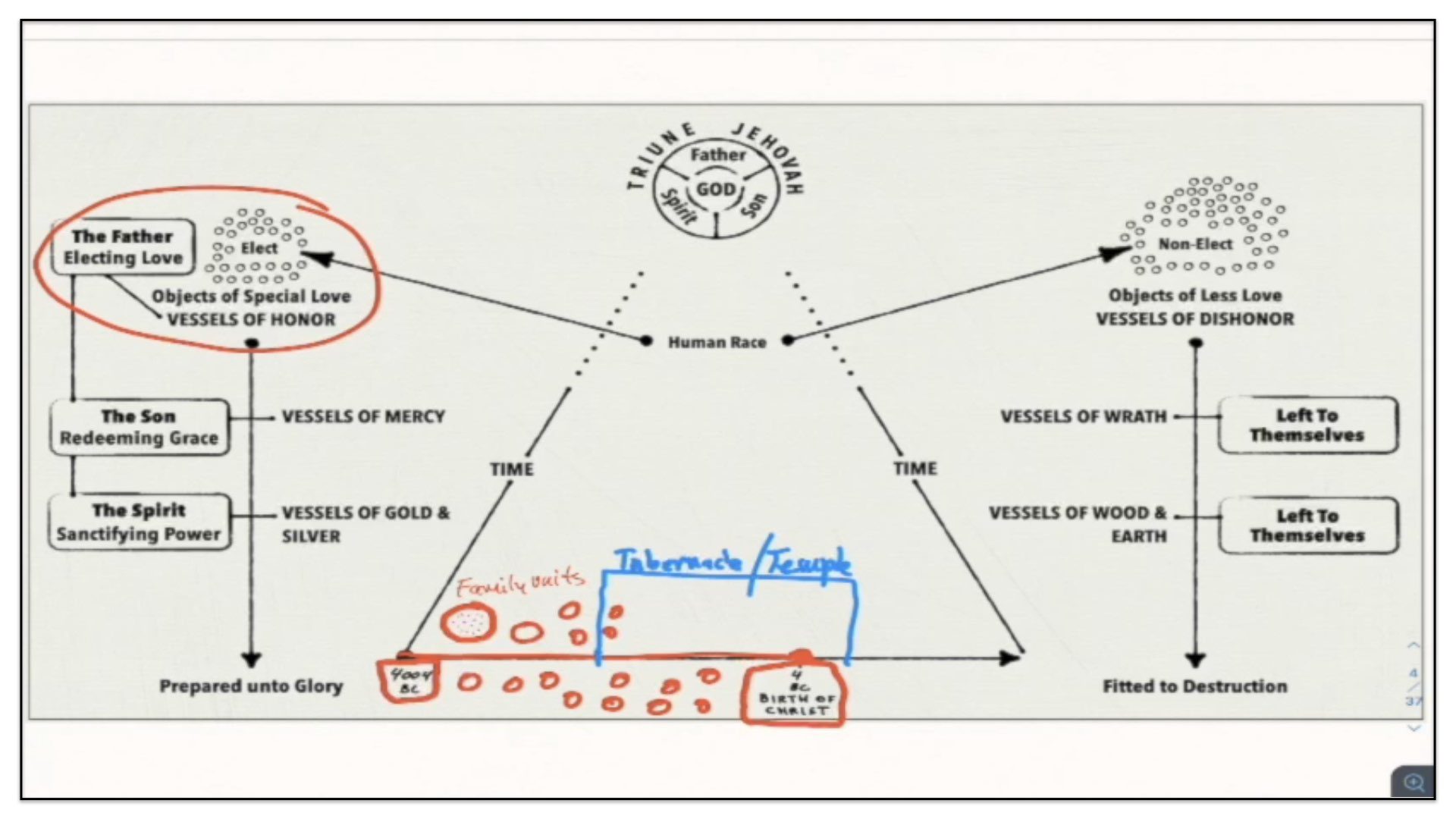
You see, we mustn’t think that God ordained these institutions—the tabernacle and the temple—to serve the central meeting place for all of God’s spiritually elect people. Here, as if God said, here’s the tabernacle and now all of the spiritually elect people that have been born again on the earth, they are now going to be meeting at the tabernacle, and later on the temple. No, no, we mustn’t see it in that way. This would be to confuse things entirely. And it’s an implausible idea. Let me just mention a couple of things that make this implausible.
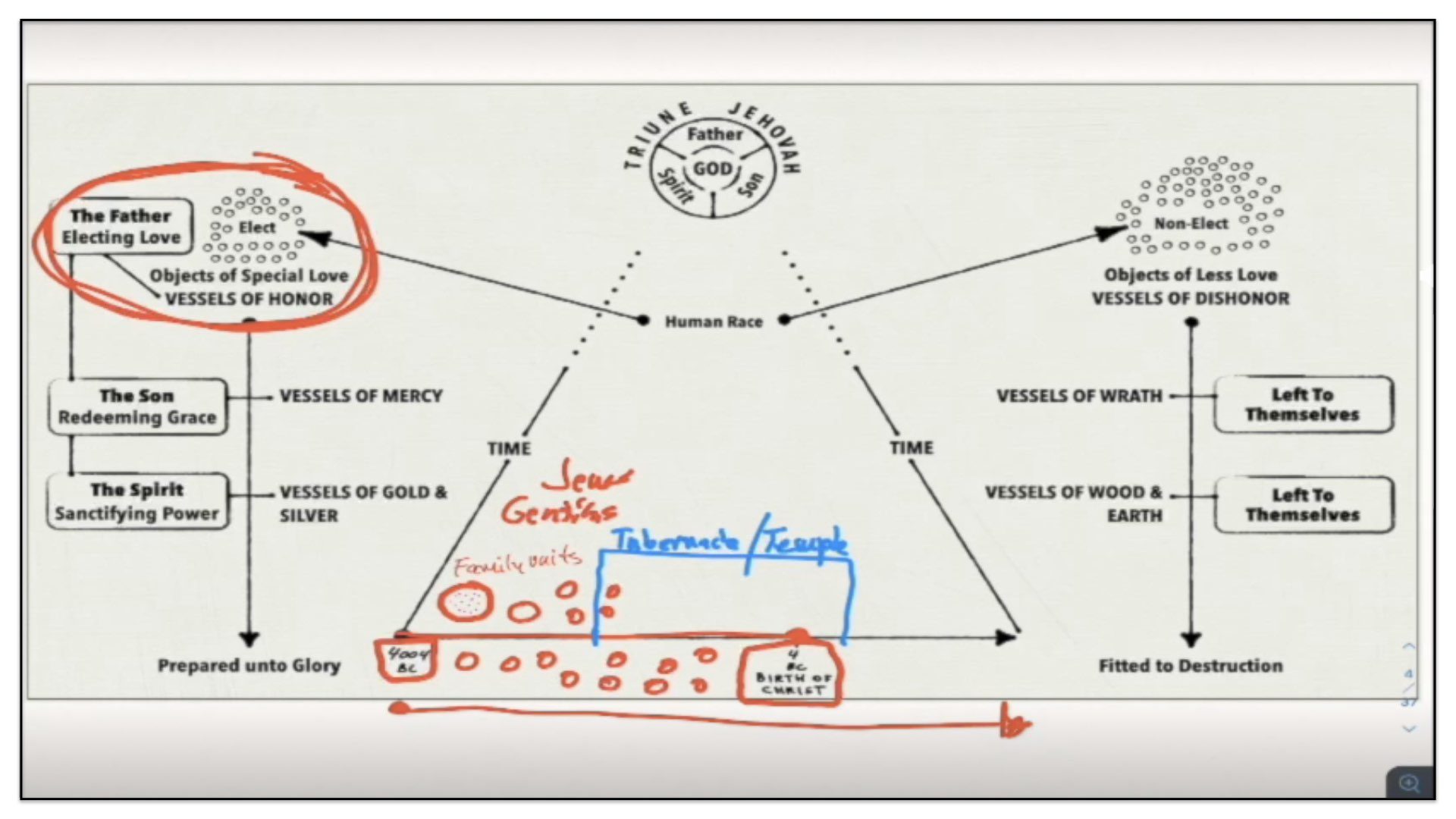
First, I’ll have you consider that God’s spiritually elect people—these people here—they have been both Jews and Gentiles, from the beginning of Adam and Eve until the end of the world. So that even while God instituted the Jewish people as a nation, Israel, even then they were outside of the Jewish people as a nation among the Gentiles, those that belong to God’s spiritually elect people. They had been regenerated, redeemed by Christ. The scriptures don’t mention them. The scriptures don’t have to record them. The purpose of the scriptures not to record the names of every person saved by grace—remember the purpose of the Old Testament scriptures primarily is to give us a record of the coming Messiah; and only those persons connected directly with the Messiah’s coming, namely His family members which are the Jewish people, those are the persons recorded in the Old Testament scriptures. But those that are not recorded, these others, the Gentiles that also belong to God’s elect people, they were certainly scattered around the world at that time.
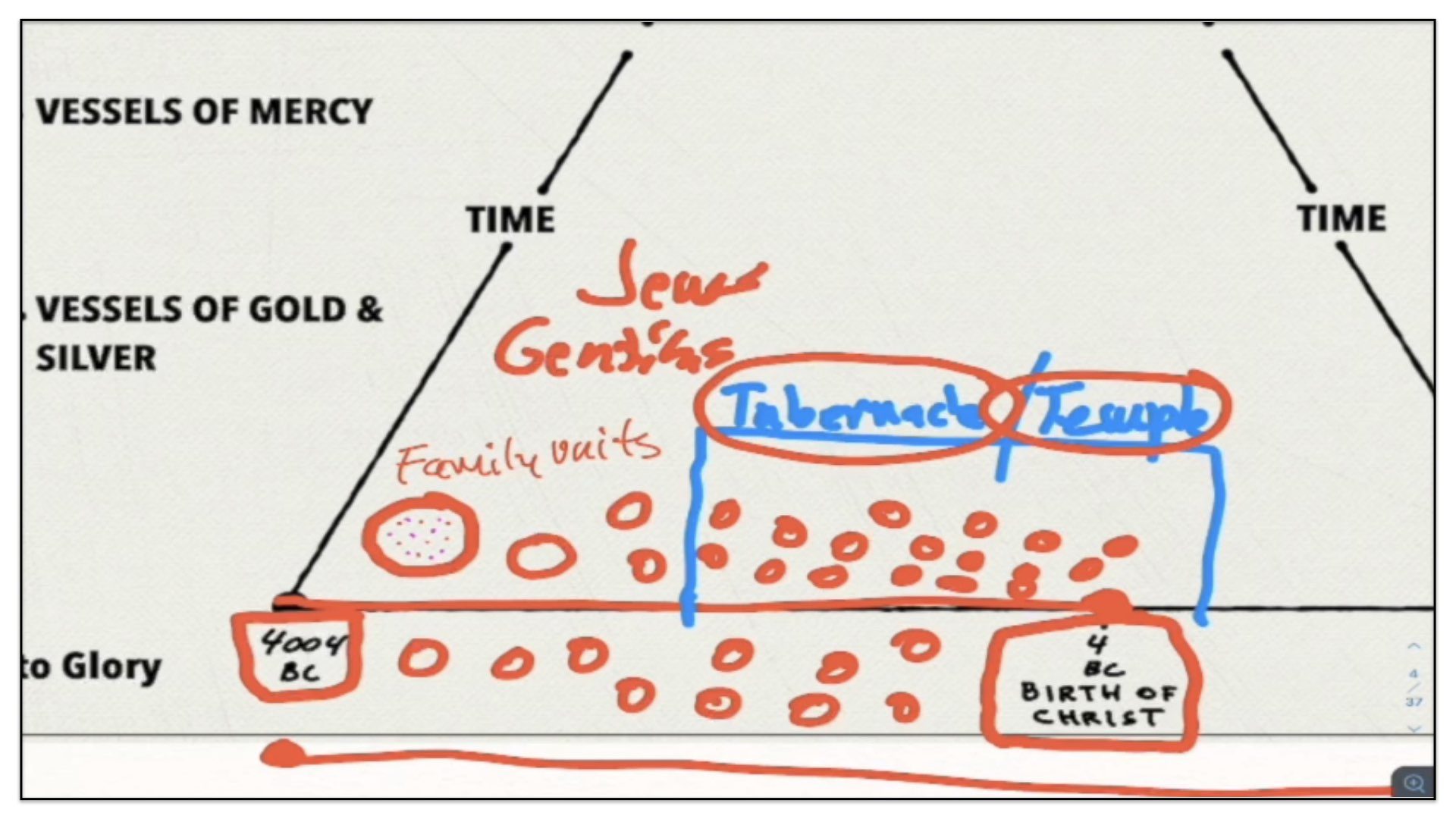
So while the tabernacle served as a national institution along with the temple for the Jewish people as a nation, it was never intended by God to be the meeting place for all of God’s spiritually elect people. No, no. What was the meeting place for God’s spiritually elect people? The family unit. The family unit. The family unit continued among the Jewish people as a nation and outside of the Jewish people. It’s universal. All Gentile nations of the world have family units and when God’s people were regenerated, they naturally met together in the context of their family gatherings.
Now I hope you’ve captured this so far in the teachings. We have here three divinely appointed religious institutions. The first of these is the family unit. The second and third of these are the tabernacle and temple. But the tabernacle and temple, though ordained by God, was designed only for the Jewish people as a nation and it was not intended to serve as the central meeting place for God’s spiritually elect people. God’s spiritually people were appointed to meet together in one another’s houses within the family context.
For The Last 2,000 Years Of History, God’s Regenerate People Meet Together Within The Local And Visible Communities Of Family Units And Congregations/Assemblies
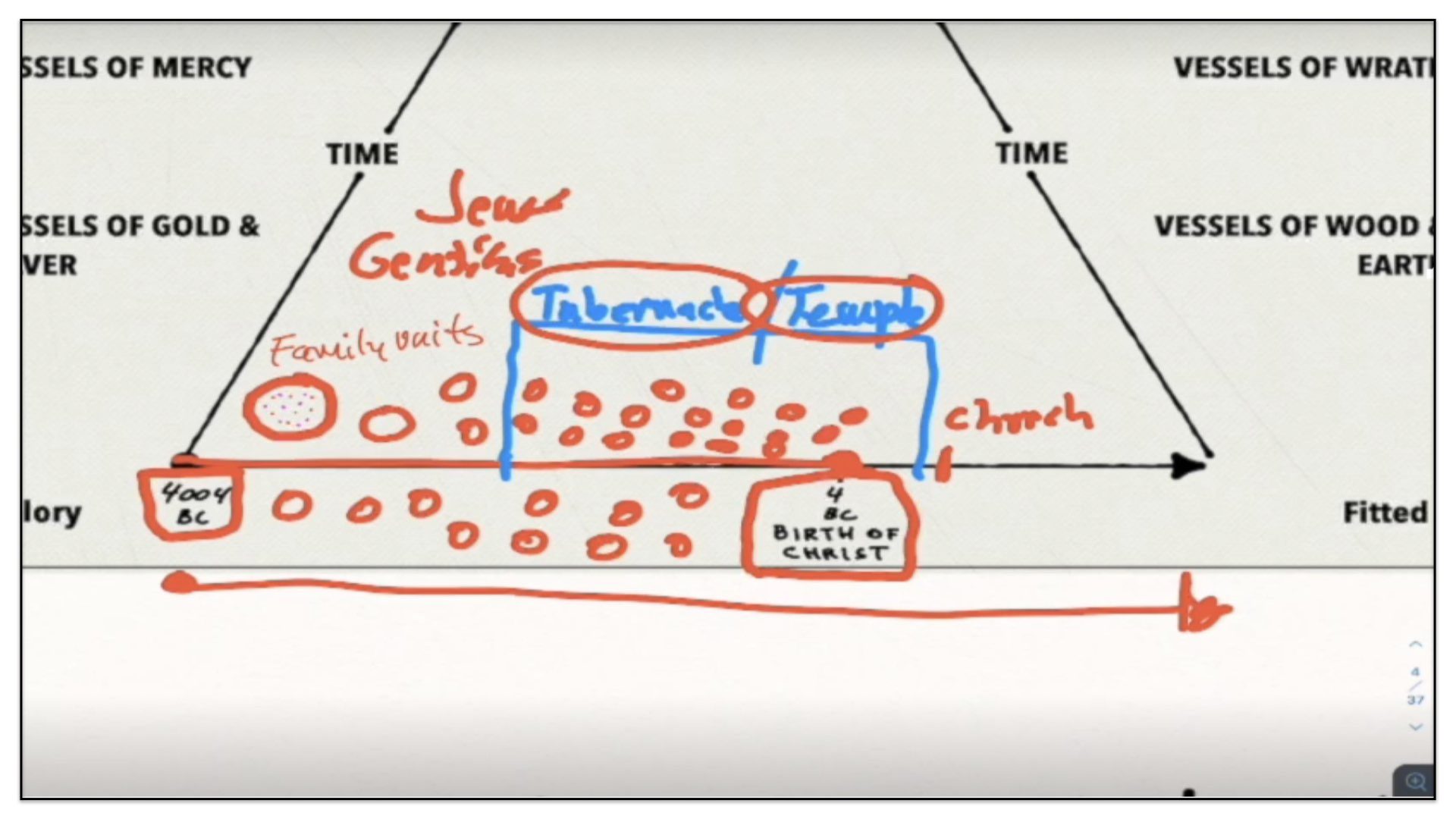
Well, then this now brings us to the earthly ministry of Christ and finally to the subject of the church. For the church is a subject that comes up in scripture only during the earthly ministry of Christ. So now I’m going to put a little marker here to represent the early earthly ministry of Christ and now the church. Let me increase the notes and I’m going to put a few words on the screen for you.
The Meaning Of The Greek Term (Ecclesia) Translated “Church” In The New Testament Scriptures
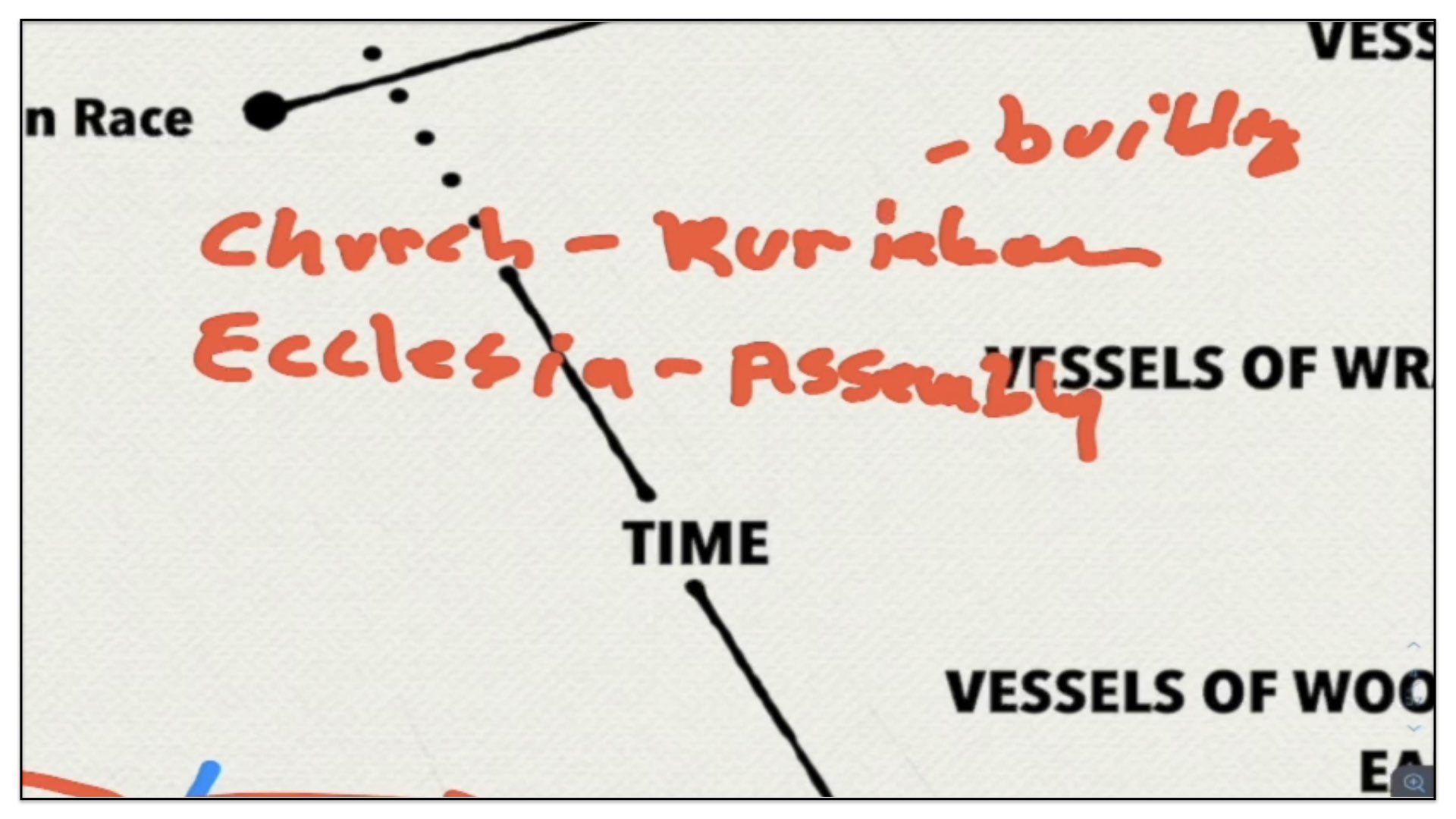
The Greek term that’s been rendered church in the New Testament scriptures is—well, let me just put the English word church—is what we find the English term to be and the Greek term from which this English term is rendered is ecclesia. However, the English word church is actually a translation of a different Greek term—kuriakon, and this Greek term kuriakon means “the Lord’s House” or “a building”, whereas the Greek term ecclesia refers not to a building, but rather, to an assembly or a congregation. This Greek term ecclesia refers to people that have been called out of their private homes and gathered together, organized as a single social unit.
The Family Unit Is The Prototype Of Christ’s Congregation
So a family in some sense is a congregation, is a congregation, a family members. But when the term ecclesia is used in the New Testament, it’s actually talking about calling God’s regenerate people out from their homes and bringing them together within the context of a special social unit or society made up of professing believers. That’s the idea we have in the New Testament of the church.
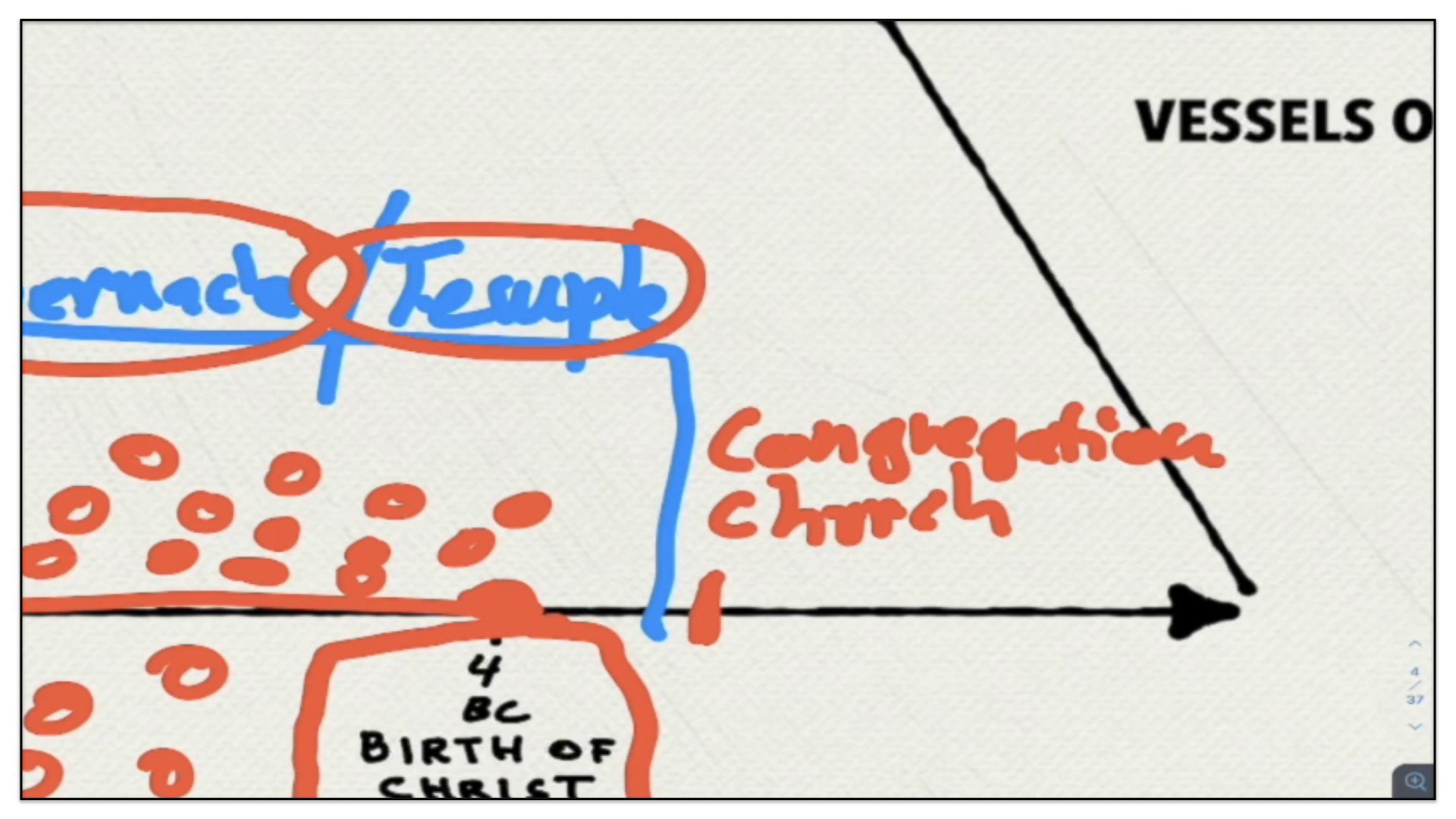
Therefore the better word to use when reading of this term church in the New Testament is congregation. In fact, when you read through, like Jesus says in Matthew chapter 16—“Upon this rock I will build my church; the gates of hell shall not prevail against it.” You could read that verse as follows—“Upon this rock I will build my congregation or my assembly, and the gates of hell shall not prevail against it. That’s the true meaning of the word church—congregation or assembly.
Christ Organized His Congregation During His Earthly Ministry
There Were Thirteen Men, Twelve Of Whom Had Made A Profession Of Faith And All Of Whom Had Been Baptized
Now with that said, you may recall that when Christ began His earthly ministry, He was baptized by His cousin John in the river, after which Christ went out and gathered together twelve men. Twelve men who had made professions of faith in Christ and who had also been baptized by John in the river. So now we have thirteen men in total, including Christ, all of whom have been baptized by John, and twelve of them, the twelve men excluding Christ, twelve of them are professing believers. In other words, they had experienced the new birth or at least that’s what they testified to.
Christ Organized These Men Into A Congregation
Now, having gathered together these twelve men Christ organized them into a church. Notice the terminologies carefully. I say organized. Christ did not plant a church. There’s no such language mentioned in scripture. Churches can’t be planted. A church is a congregation or an assembly. You can’t plant a group of people. But you can organize them. You can call a group of people together and organize them into a body. And that’s what Christ did. He called together these twelve men and He organized them into a body, into an assembly. The Assembly of Christ. Christ’s assembly. Henceforth, and listen to this carefully, when we read through the gospel records, we mustn’t view Christ and His twelve disciples as a disjointed group of people, as if the church had not yet been organized. As if this is just twelve men, professing Christians, that are following Christ. As if these twelve men were just students under the tutelage of Christ. If we read the four gospel records thinking that that’s all this was between Christ and His twelve disciples, we’re making a monumental mistake in our understanding of the scriptures. Please listen to me. Throughout the gospel records, Christ organized His church when He called those twelve men together. That’s towards the beginning of His earthly ministry. Which means every time Christ met together with those twelve men, the church was gathering, that assembly was coming together. So when you read the four gospel records, we’re reading not only of Christ and His earthly ministry, but also of the first church organized by Christ and the ministry of that church is Christ and His disciples went about preaching the gospel and ministering to others.
The Congregation Of Christ Was Not Organized On The Day Of Pentecost
Now I certainly believe the scriptures bear out this teaching and it does so quite clearly. I’d like to highlight for you from the scriptures some of the things we know to be true about the first church organized by Christ. Before I highlight these for you, let me just mention the common or popular view is that the church was organized after Christ died. After He rose again. And after He ascended into heaven. And many people pinpoint the first church to have been organized in Acts chapter 2 on the day of Pentecost. Now there is no scripture that specifically tells us the church was organized on the day of Pentecost. That’s a presupposition. And I do not believe the scriptures bear testimony to that idea. Rather, I believe the church was organized by Christ Himself at the very beginning of His earthly ministry. And these are some of the points that I believe affirm that.
The Congregation Of Christ Had Been Clearly Organized During His Earthly Ministry
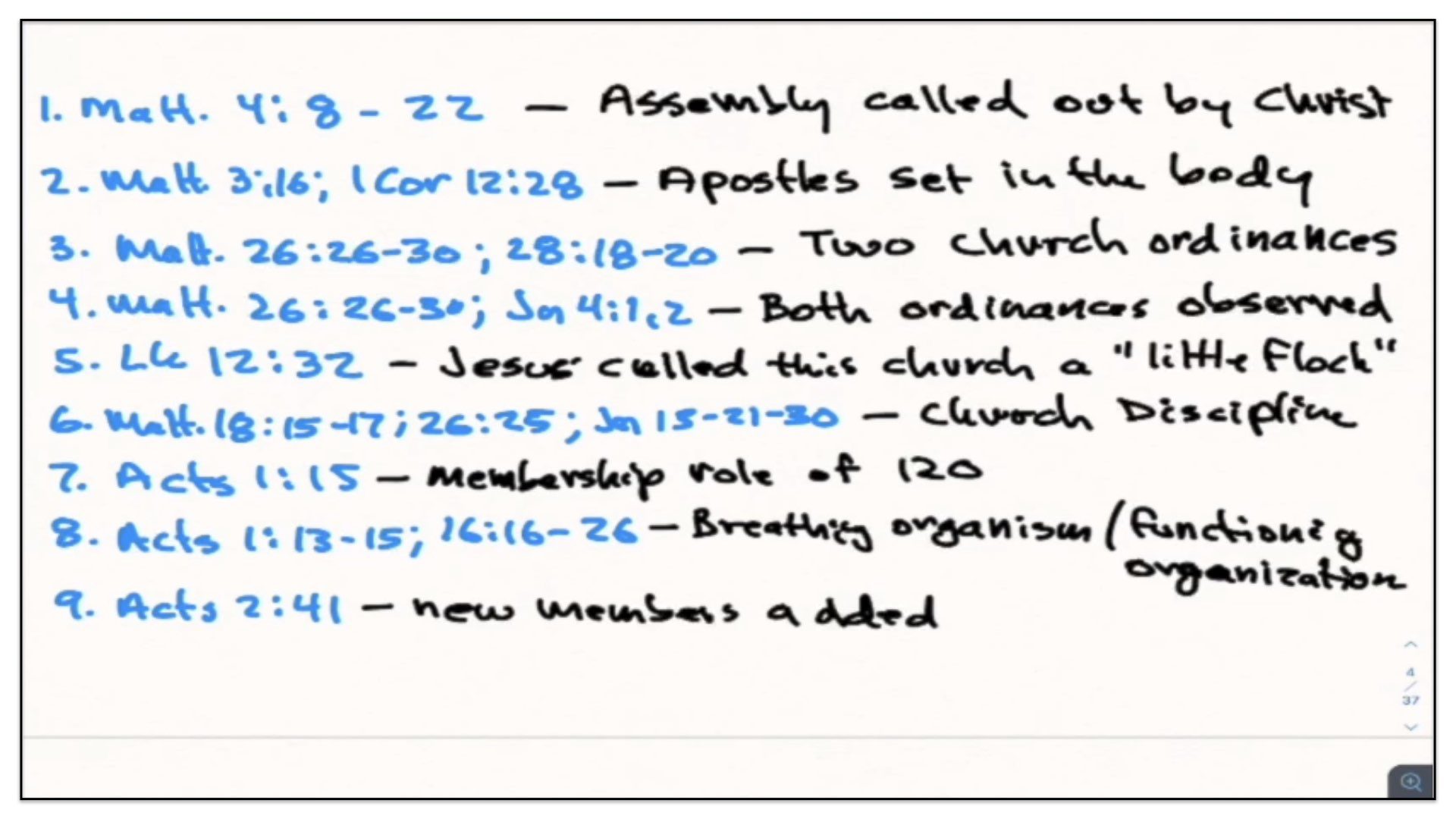
I’ve listed them on the screen for your easy perusal and you can take a screenshot of this since this is a video teaching and you can study these scriptures and these points in your own time. I’m just gonna highlight them for you. Look in Matthew chapter 4, we have an assembly or a body that has been called out by Christ when He began His earthly ministry composed of Himself and His twelve disciples, all of whom had been previously baptized. And then in Matthew chapter 3 and First Corinthians chapter 12, we know that Christ had already set the apostles in the body, which is the church. And then in Matthew chapter 26 and 28 Christ already commissioned the church to observe the ordinances of baptism and the communion table. And then according to Matthew chapter 26 and John chapter 4, both of these ordinances were observed by this church prior to the day of Pentecost. And then according to Luke chapter 12 Jesus called this church He organized a little flock. And then in Matthew chapter 18, chapter 26 and John chapter 15, Christ is exercising the rule of discipline within this church that He organized. He actually excommunicated Judas before the betrayal. And then in Acts chapter 1 we have a membership role of a hundred and twenty people prior to the day of Pentecost. If the church was not yet in existence before the day of Pentecost, how could they have a hundred and twenty members? And then in Acts chapter 1 and chapter 16, we learn that the church is both a breathing organism and a functioning organization. It should be Acts chapter 1, not chapter 16. Acts chapter 1, where the church is functioning as a body in Christ prior to the day of Pentecost. And then finally according to Acts chapter 2 we learn that 3,000 were saved on the day of Pentecost after which they were baptized and the language is they were added to the assembly of Christ. How could they be added to the assembly of Christ if the assembly of Christ was not yet established until the day of Pentecost?
Some Basic Features Of The Congregation Organized By Christ During His Earthly Ministry
I hope you see the point that I am driving at there. Look, everything we gather from these scriptures teaches us that the church is a body. Here, let me bring you to another set of notes here. Watch this. I’ll try to draw it out diagram it for you. Watch.
A Body Of Baptized Believers Following His Commands

Everything these scriptures teach us is the church is a body of baptized believers—these dots represent baptized believers—it’s a body of baptized believers covenanted, agreed, contracted to follow the commands of Christ. Who have they covenanted with? The baptized members have covenanted with God and also with one another to follow the commands of Christ. And that’s what makes them members of one body, a local, visible body of baptized believers.
A Membership Of Only Thirteen
Now, the first church organized by Christ had only thirteen members. So there’s too many dots in the circle now, but if you were to mentally remove the dots until they number thirteen, that’s how many members Christ organized into His church during His earthly ministry. It was Himself and the twelve disciples.
The Lord’s Table Was Designed By Christ To Be A Church Ordinance (Closed Communion), Around Which The Congregation Maintained Discipline
Now as I just pointed out, it was this church—Christ and His twelve disciples—which met together in the upper room prior to Christ’s crucifixion, where Judas, one of the members of the church, was excommunicated from the fellowship. And it was only after church discipline had been exercised and Judas was excommunicated that Christ then instituted the Communion Table.
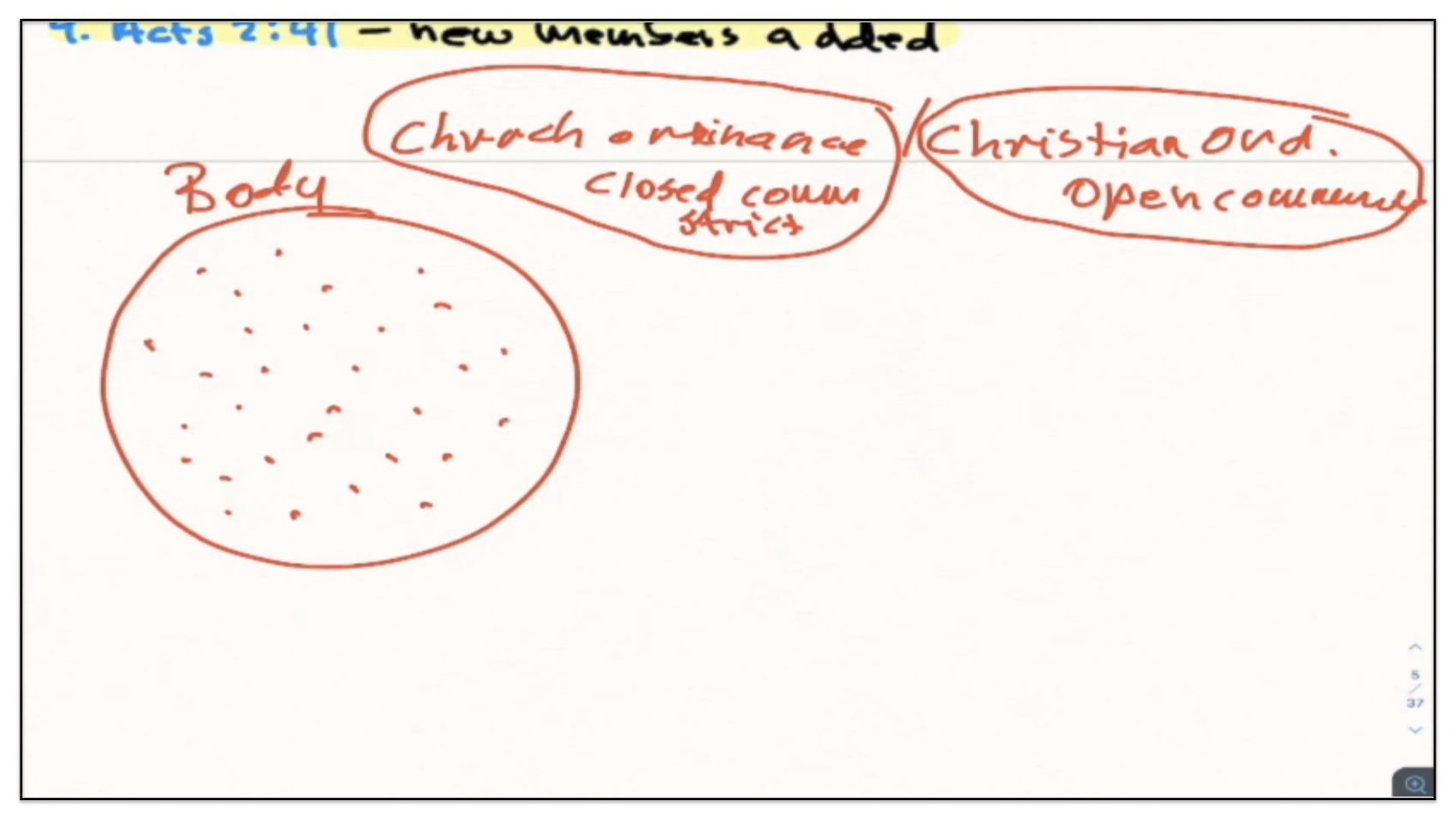
I will therefore have you note, the Lord’s Table when Christ instituted it, it was given by Christ to serve as a church ordinance, not a Christian ordinance. That’s where a lot of people go wrong in this discussion on the Communion Table. The difference between a church ordinance and a Christian ordinance. Those who believe in something called Open Communion, meaning all Christians are welcome to sit at the table whenever they come together, they believe the Lord’s table is a Christian ordinance open to all Christians. Whereas those who believe in something called Closed Communion, or Strict Communion, they believe that Christ gave this ordinance to His church, to the body, to the local and visible gathered body of baptized believers. And it’s closed or restricted, meaning it’s only opened to those who belong as members of that body, that have covenanted together in that location to follow the commands of Christ.
Now you see, it’s really not a complicated issue. Is the Lord’s Table a Christian ordinance or a church ordinance? Of course, when Christ instituted the Communion Table in the upper room prior to His death, don’t you think He had opportunity to invite all Christians in Jerusalem to join for the occasion? think of it. It’s on the eve of His death. Christ is about to be betrayed and arrested. He’s going to be crucified. There were many precious disciples living in that location and yet when Christ instituted the important ordinance of the Communion Table, He did not invite all of these other disciples. Why? Because they were not members of the body. Christ had not added those disciples of Christ to the local visible body. And I believe the reason Christ did not bring them into this local visible body is because Christ is setting for us a pattern. A pattern on how all churches are to function.
The Church Is Designed To Be Few In Number (Reflective Of The Family Unit)—Large Churches Should Multiply Into Smaller Churches Within The Community
Churches are to be local and visible even as Jesus Himself had organized it. And when a church reaches a size which moves beyond the limits of the place it meets, let’s say it’s in a house and it can only seat thirty people, then the church naturally divides and a new house church is formed or organized. And in this way churches are multiplied in communities and countries and across the world in small gatherings of God’s people, baptized believers. I hope you get the point.
Now, by the time Christ ascended into heaven, I’ll point out to you as as I mentioned, there’s thirteen members in the first church Christ organized. The Lord’s Table is instituted, but now Christ is crucified, so no longer are there thirteen members. Now only twelve members. And then Judas has been excommunicated and shortly afterwards he commits suicide. So now the church no longer has twelve but eleven members. So this church of eleven members, prior to the day of Pentecost now has a hundred and twenty members. So at some point between the death of Christ and the day of Pentecost, the church grew by over a hundred people. That’s amazing. That is a hundred baptized believers joined or were added to the initial eleven members that remained of this church. And then on the day of Pentecost, there were 3,000 plus people saved, converted to Christ and baptized and added to the church. So now the church in Jerusalem that Christ organized went from just thirteen members down to eleven members then up to 120 members and now over 3,000 members. But watch this, and I just touched on in the moment ago.
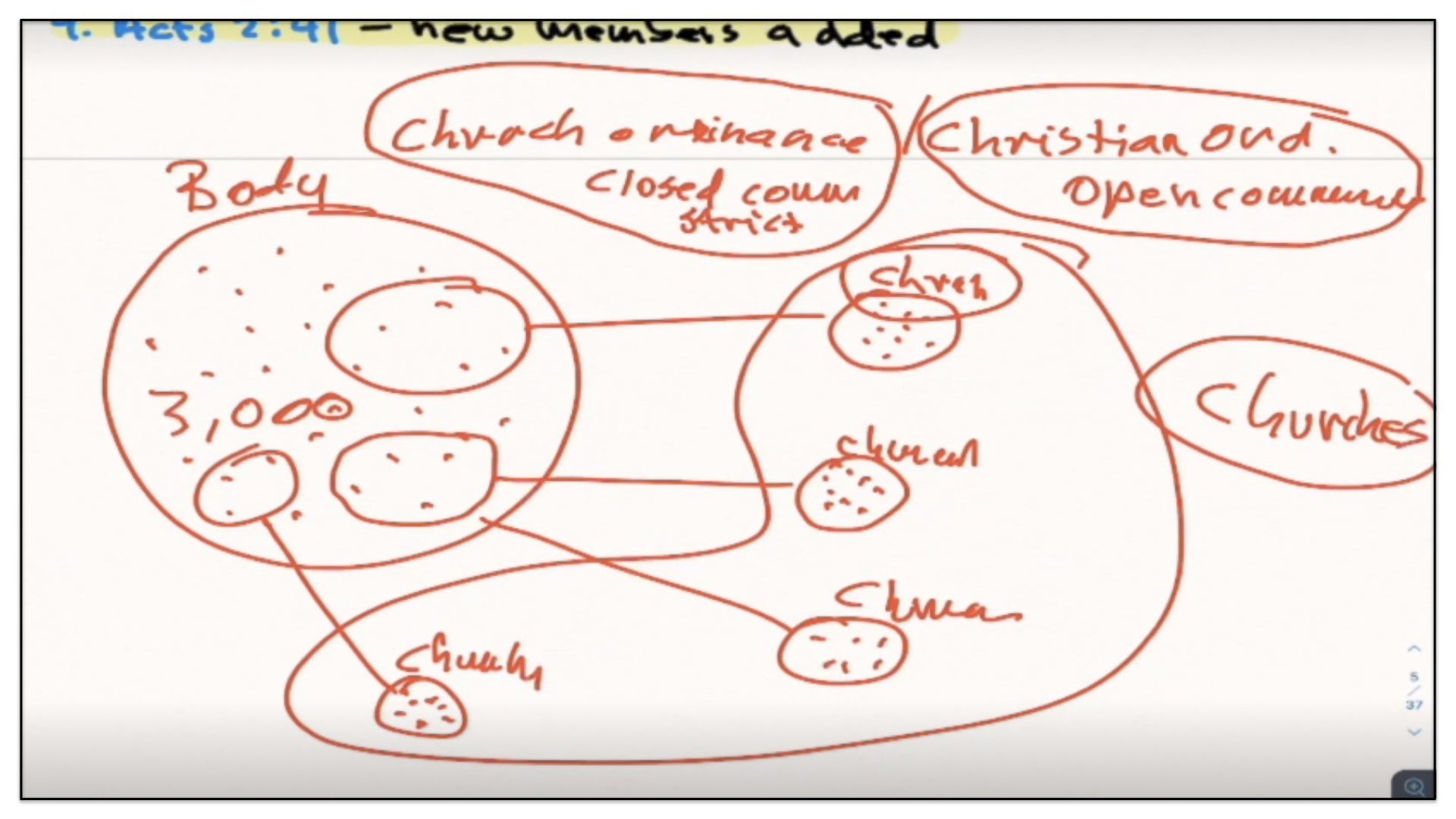
How did the church in Jerusalem meet together if there were 3,000 plus members of that congregation? They didn’t. This was the beginning of the multiplication of churches. The churches in Jerusalem gathered together in new groupings of people. So this huge group of 3,000 people, they started to divide into independent congregations. And they would each, each of these little congregations, would usually meet in a house, but they weren’t limited to a house. They can meet anywhere they wanted to. But it was this group of people and each of these little churches. So that’s a church. That’s a church. That’s a church. There were hundreds of them all scattered around Jerusalem. That’s a church. And you see when one church is referred to it’s in the singular. When two or more churches are referred to it’s in the plural, churches. And the scriptures bear out the scriptures use the term in the singular when referring to one church and uses it in the plural when referring to a multiple number of churches. I hope you understand the points I’m making here on what a church is.
Each Local And Visible Church Is Recognized As “The Church Of Christ”—An Autonomous, Local And Visible Congregation Of Baptized Believers Covenanted To Follow The Commands Of Christ
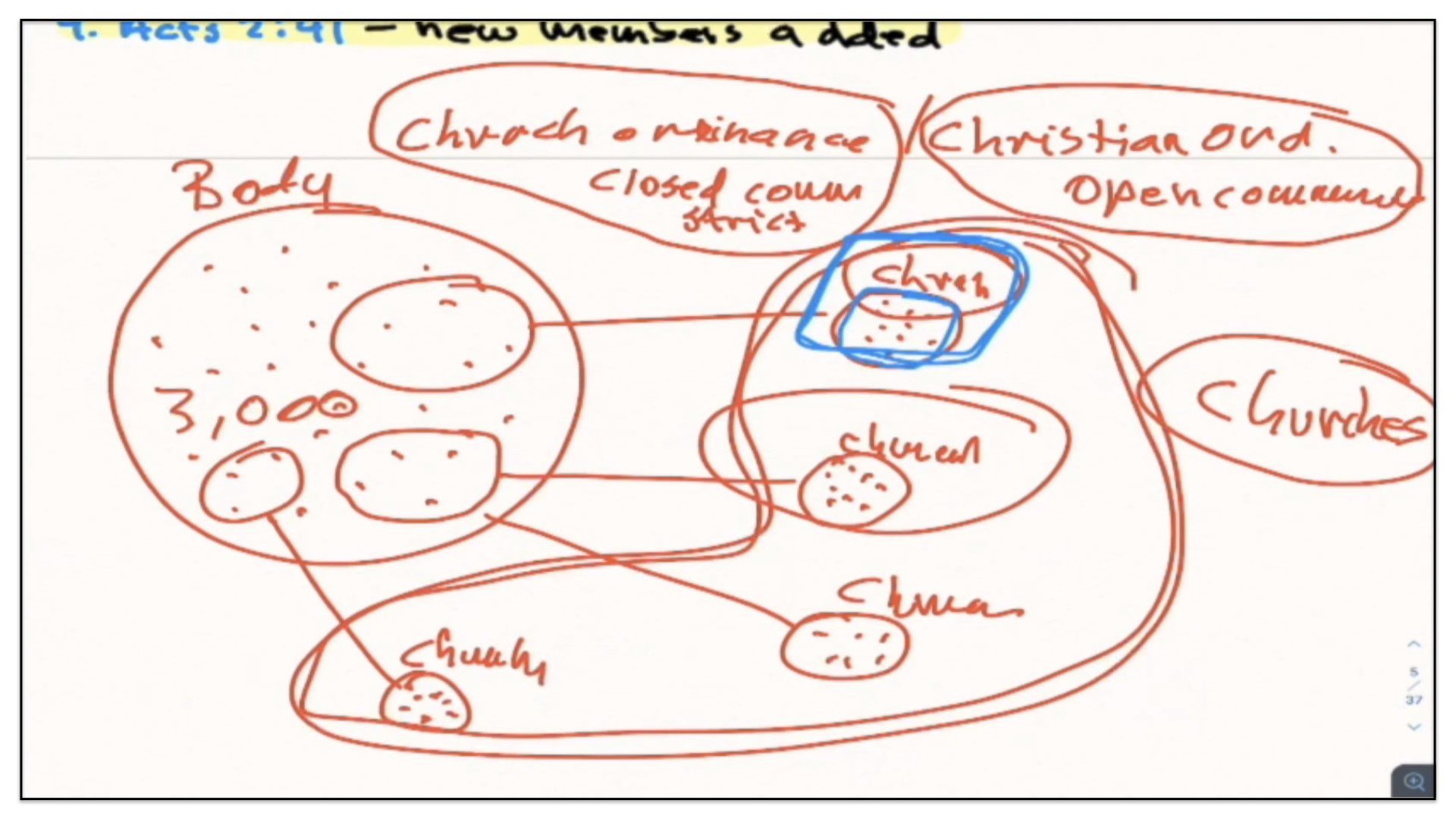
Let me just back up and say this very quickly. I’ll just change color pens so you don’t get lost in the notes, color blue. So watch. Practically speaking, when we say I belong to the assembly of Christ, we’re not saying by that language that I belong to God’s spiritually elect people as a whole. That has a different label. The elect, or the family of God would be labels that are good. If you just want to say I’m a Christian, I’m one of God’s elect, one of His redeemed people, I’m a child of God or a brother and sister in Christ. Those analogies and that language is good if you’re referring to yourself and the broad spectrum of all of God’s elect people. But if you’re referring only to those people that you’ve covenanted with to worship God in a society, a local and visible grouping of baptized believers, then when you say I belong to the assembly of Christ, you’re referring specifically to that local community. To your particular brothers and sisters in Christ you know by name, you meet with every Sunday and during the week you pray together with them, you sit together for spiritual edification, you share one another’s burdens, you rejoice when one rejoices, you mourn when one is grieving. That is the assembly of Christ. I belong to the assembly of Christ. It meets here. Near where I live. If you’re a baptized believer and have covenanted with a group of God’s people then you too belong to Christ’s assembly. But your assembly is different from mine. Yours is truly called the assembly of Christ and so is my mine, it’s also the assembly of Christ. But you see, our assemblies are different in the sense that you belong to your particular local grouping of God’s people and I belong to mine. Just as the family unit. Every family has its own unit. You don’t use the word family in a universal sense to refer to all families in the world. That concept doesn’t work. It’s not practical. We refer to the word family and the context of a local and visible gathered group of people. And likewise with the church or congregation of Christ. It’s a local visible gathering of God’s baptized believers in Christ.
There Are Four Divinely Appointed Institutions Throughout The Course Of History—The Family Unit And The Congregation Of Christ Continues Today
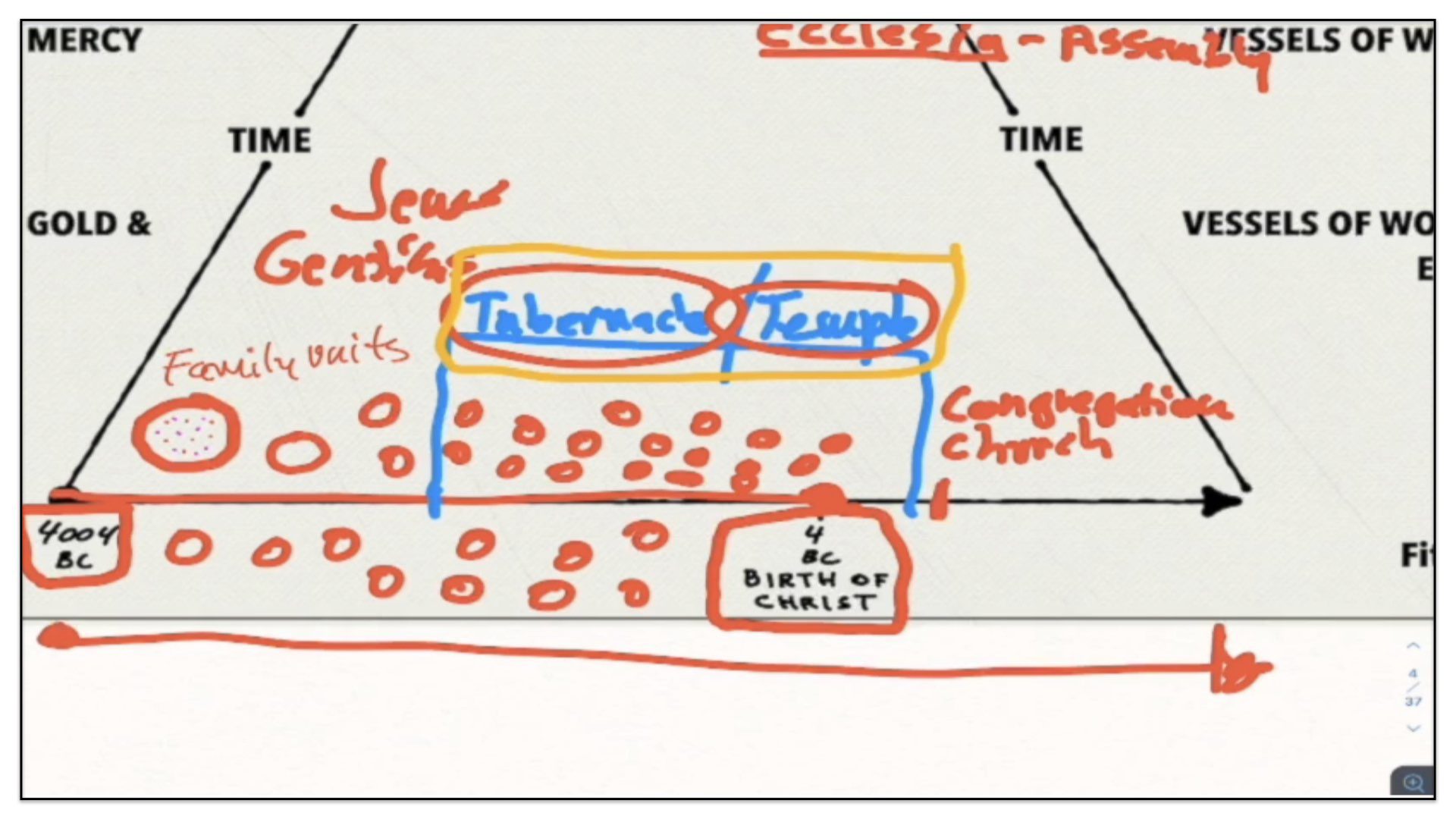
Okay, well when I’ve tried to show you I’ll just back up to these are earlier notes. What I’ve tried to show you there are four divinely appointed institutions throughout the course of history. Let me change the color pen, I’ll choose orange. There are two national institutions designed only for the children of Israel between the years 2500 BC and 70 AD. This is the tabernacle and the temple. But God’s spiritually elect people were not invited to meet. There is the sensual meeting place prior to the earthly ministry of Christ. These were national institutions.
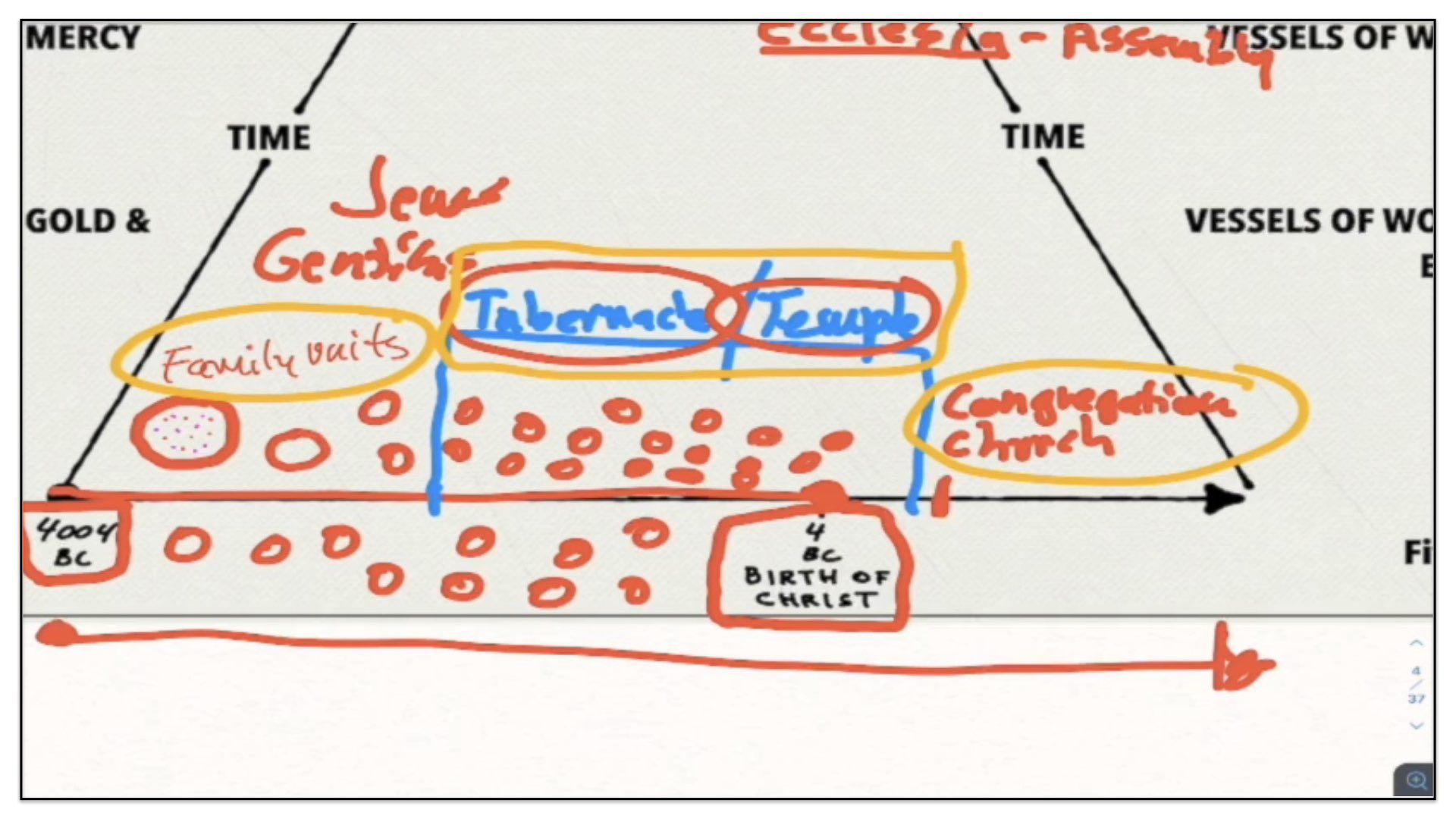
The other two divinely appointed institutions are the family units and the assemblies of Christ, the congregations of Christ. Now it’s within the context of these two institutions that all of God’s spiritually elect people throughout the ages have been meeting together for worship and spiritual edification, in the family unit and the assembly of Christ.
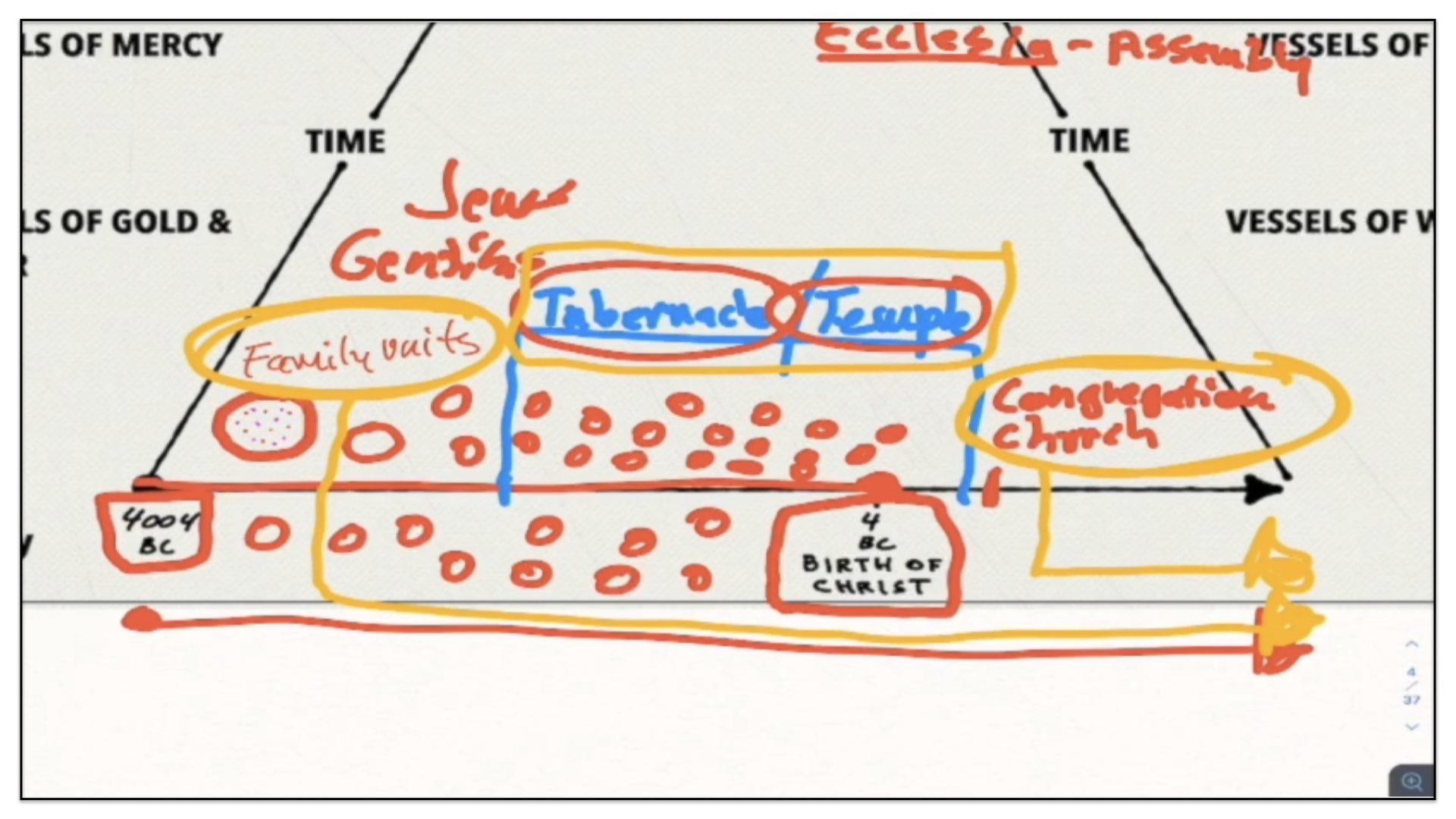
Now watch. The family unit continues even till now. Even now regenerate sinners are to meet together for family worship. We should. It’s a perpetual institution. It hasn’t ceased when Christ organized His assembly. It continues even now. The family unit will continue until Christ returns. But the second institution organized by Christ during his earthly ministry, this assembly where all of God’s regenerate people called out from their homes, baptized and then added to a proper assembly of God’s people apart from their family units, that assembly of Christ will also continue until Christ returns.
A Side Point—The Jewish Synagogue Is Not A Prototype Of The Church, Especially In Terms Of Plural Elderships
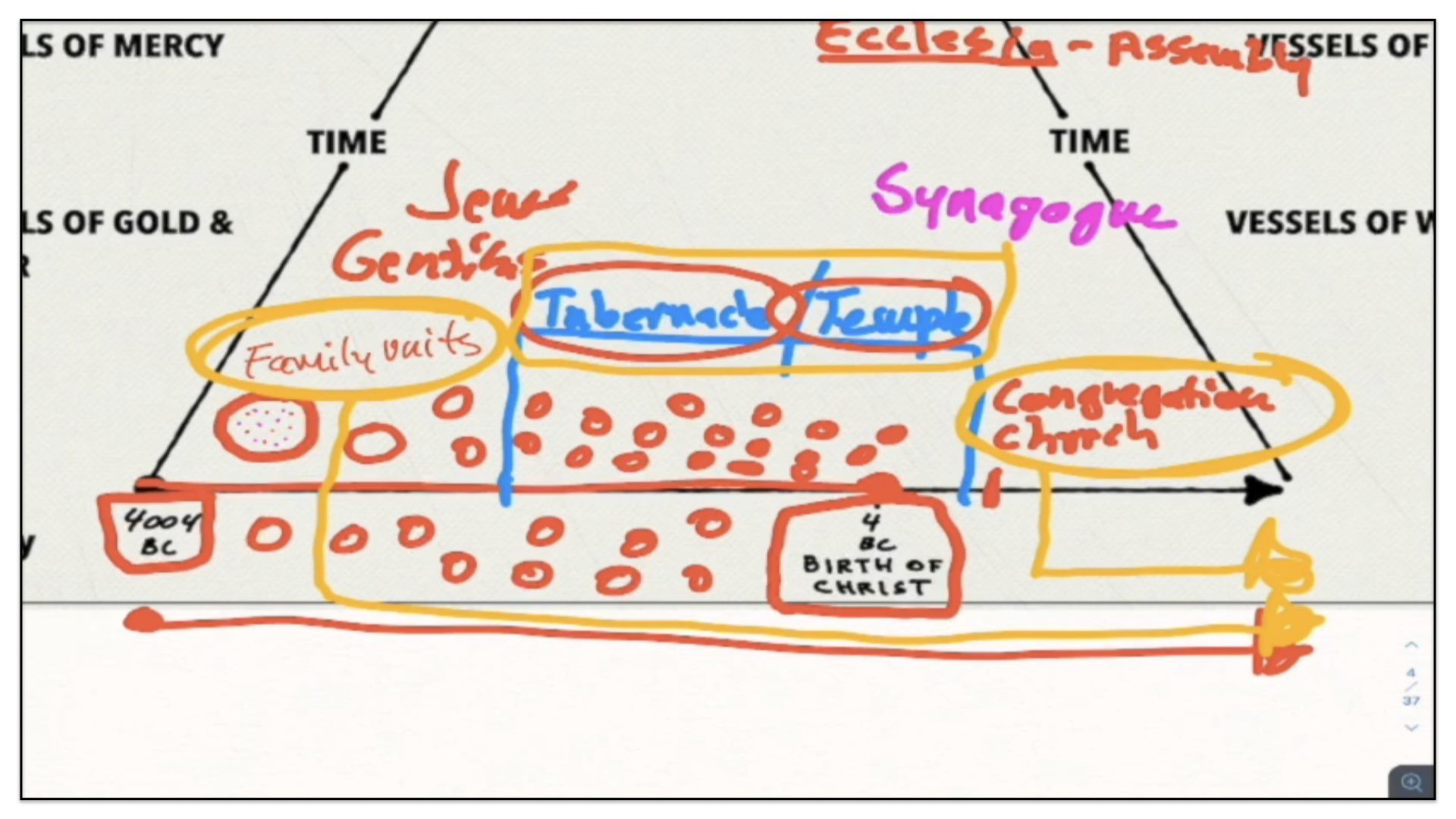
Now, I’d like to ask you since we’re on this topic, it is a side point, but I want to highlight it for you. Where does the Jewish synagogue fit together with these four institutions? The Jewish synagogue. Where does it fit together with these four institutions? The Jewish synagogue, of course, is different from the tabernacle and the temple, and certainly different from the family unit and the church. Well, the Jewish synagogue is actually not a divinely appointed religious institution. It’s not. The Jewish synagogue is a man-made institution which came into existence among the Jewish people as a nation during the time of their dispersion across the world and their decline as a nation.
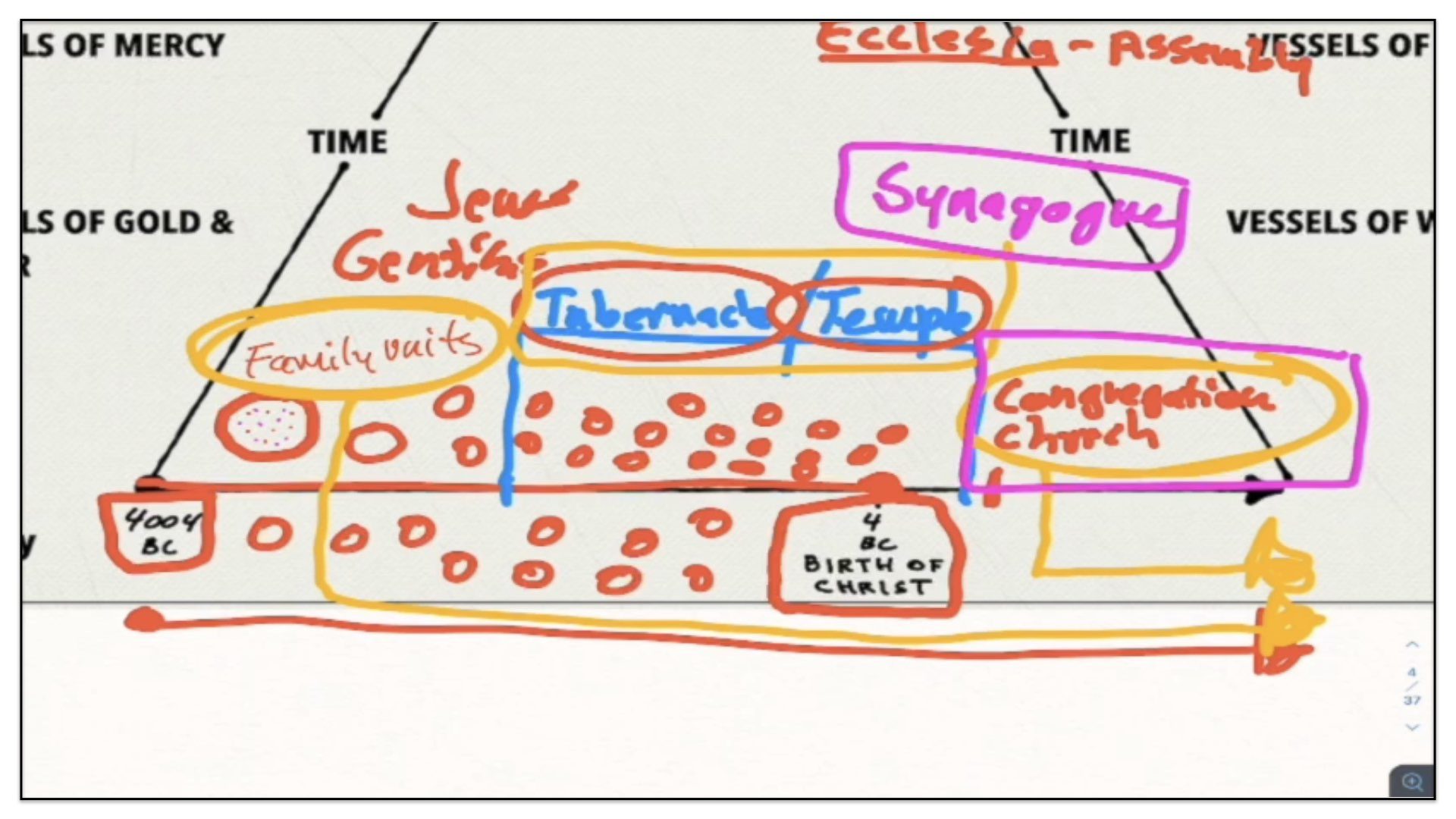
However, and watch this, this is the important point—many Reformed believers and I’ll highlight the Reformed Baptist particularly, they believe that God designed His church according to the blueprint of the synagogue. This serves actually as one of their leading reasons why they insist the church should be overseen by a plurality of elders. They say, “Ah, the Jewish synagogue had a plurality of elders, so must also the church.”
Now here’s my challenge on this point. Upon what basis do they establish this view that God designed the church according to the Jewish synagogue? Why would God do such a thing? Why would God design His assembly after a man-made institution? God never made it. He never designed it. And neither is there any biblical reference to the church being designed according to the blueprint of the Jewish synagogue.
But another challenge I would bring to this idea presented by the Reformed Baptists, upon what authority do they correlate the elders of a Jewish synagogue to be the same as pastors presiding over a church? The office of Pastor is a special office originating with Christ. Christ created that office and its special gifting to those that fill that office. Elders of the Jewish synagogue never had the gift and calling of Pastors. And neither were they ever in a position to be shepherds or pastors in the way that Christ ordained that office for His assemblies.
Now, I believe the Reformed Baptists are quite confused on these matters. And they’re responsible for undermining and perverting Baptist polity in churches over the course of the last 70 years.
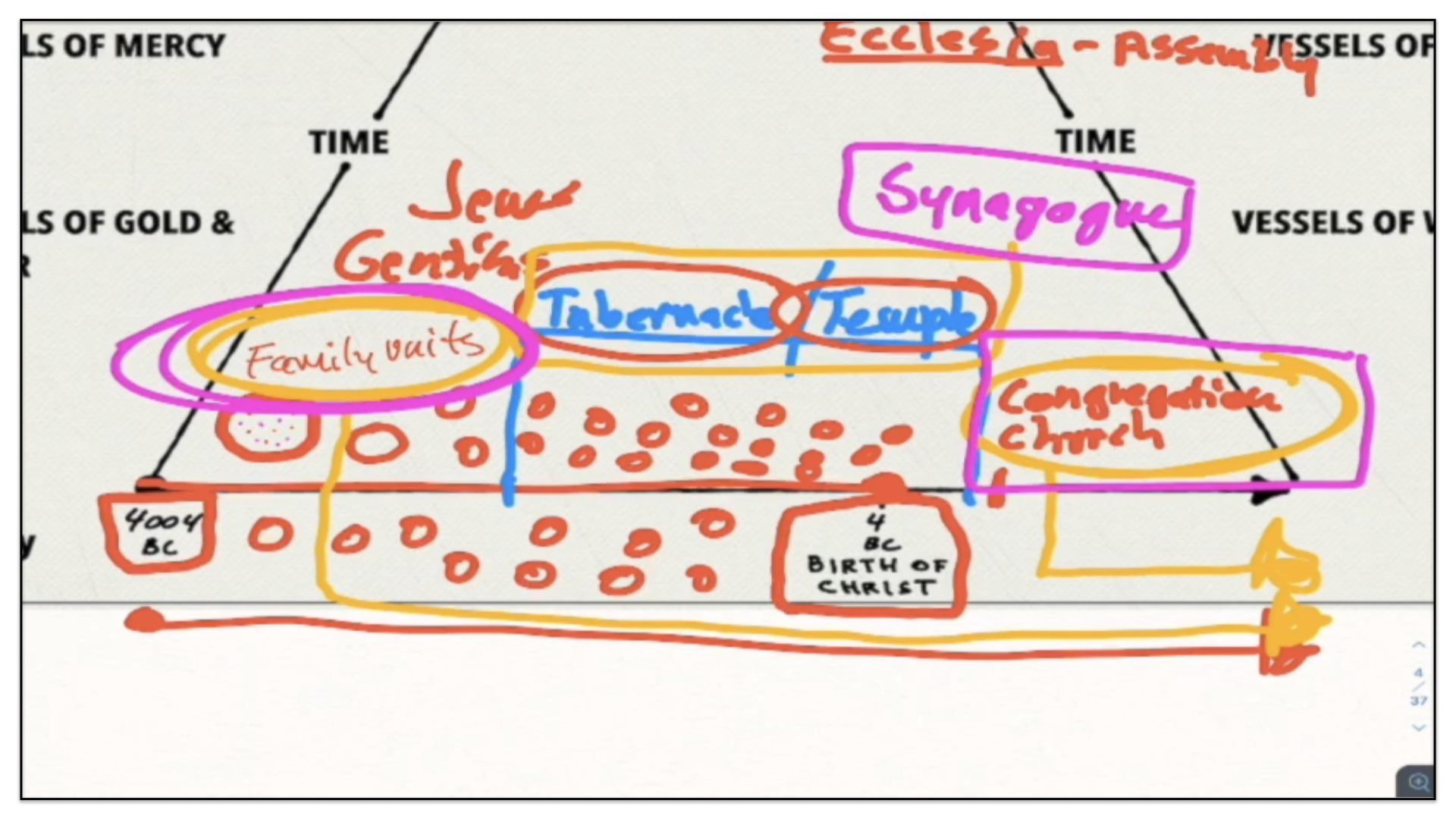
No, no my friends. Listen to me carefully, God never designed the church according to the blueprint of the Jewish synagogue. Rather, watch this carefully, God designed the church according to the blueprint of the family unit. The family unit is the first divinely appointed religious institution for the elect and it is on that model God designed the church, which is the second divinely appointed religious institution for the elect.
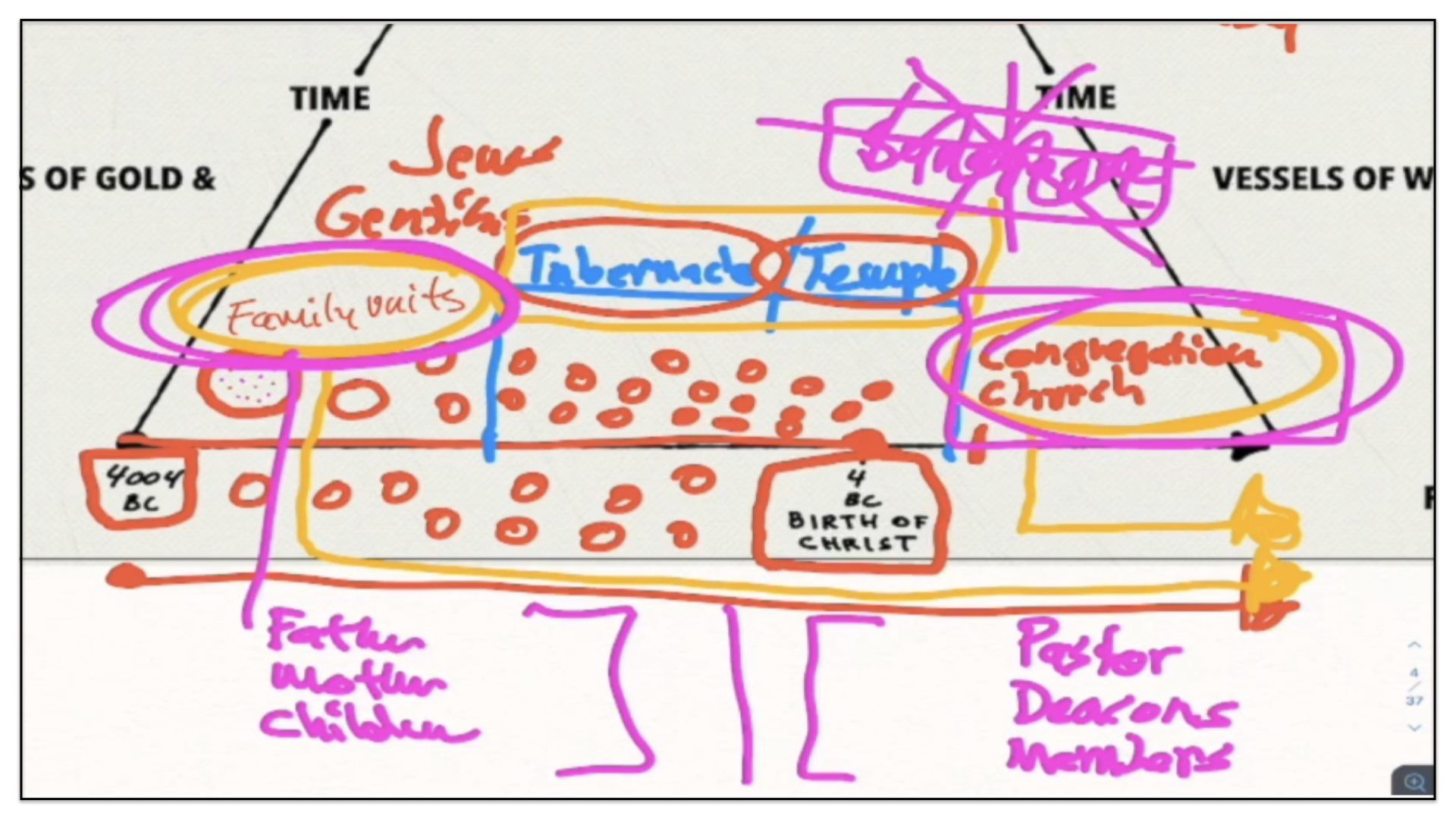
You see, there are three groups of people within the family unit. There’s the husband/father, there’s the wife/mother and there are the children or brothers and sisters. If you take that model and correlate it with that of Christ’s assembly, then you find a natural proportion of leadership and governance within the two institutions. It was the father that took the lead and presided over the family. It is the father that takes the lead and presides over the family, assisted by the wife/mother, with the children being led and fed by the parents. In a similar fashion, you have the pastor presiding over the assembly of Christ as an under-shepherd, assisted by a group of deacons, the church members of which are being led and fed by those ministering to them. And you see here how it’s the family unit that serves as the model for the polity of the assembly of Christ. It is not the Jewish synagogue. Alright. Well, thanks for your patience as I chased that rabbit on a polarity of Elders, but it all ties together with the general topic of the church.
Two Common Errors Among Reformed Believers As It Relates To The Church And God’s Elect People
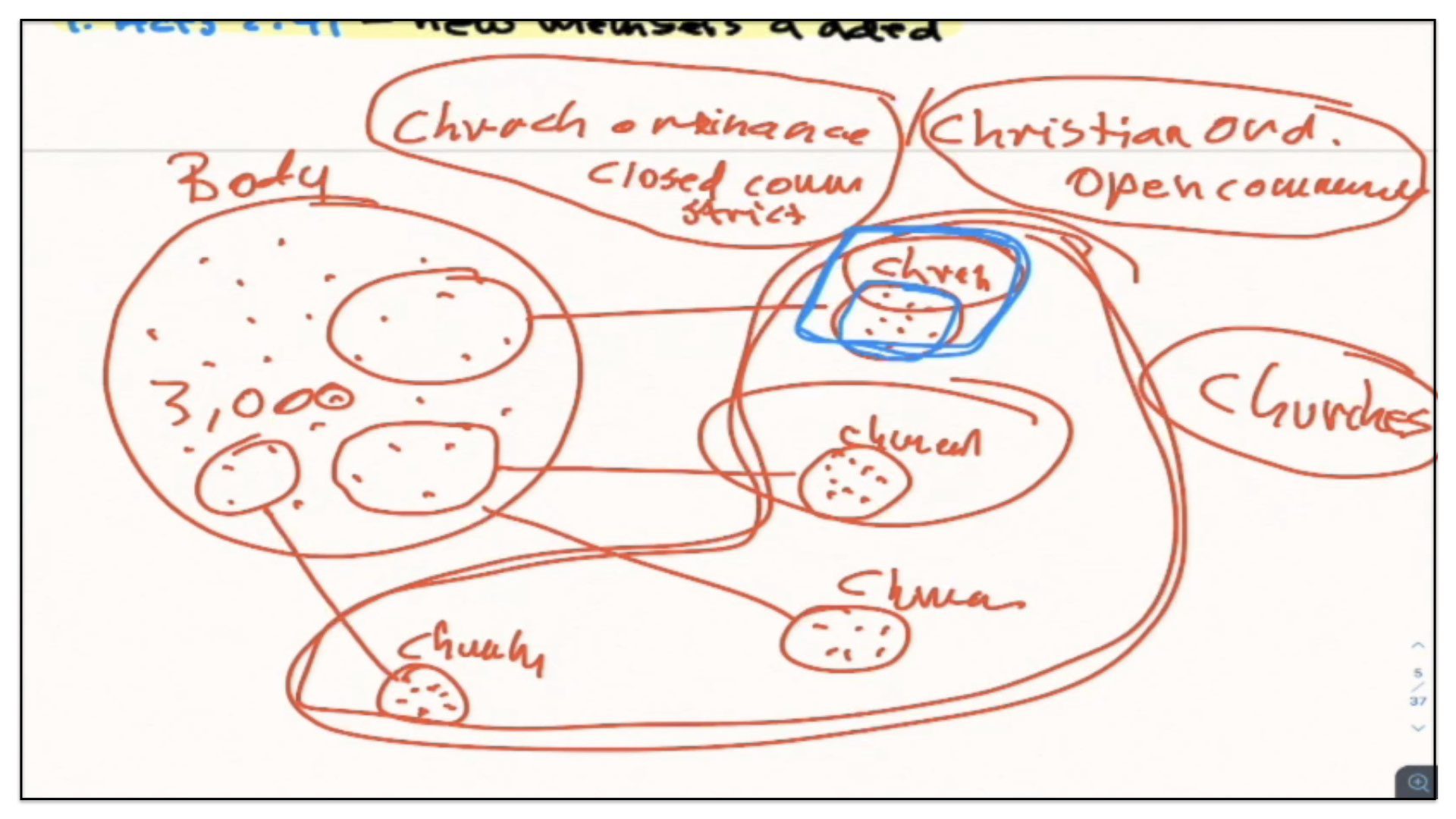
Back to the main point. The church is, as I pointed out, a local and visible body of baptized believers, covenant to follow the commands of Christ. However, this understanding of the church is not shared by all Christians.
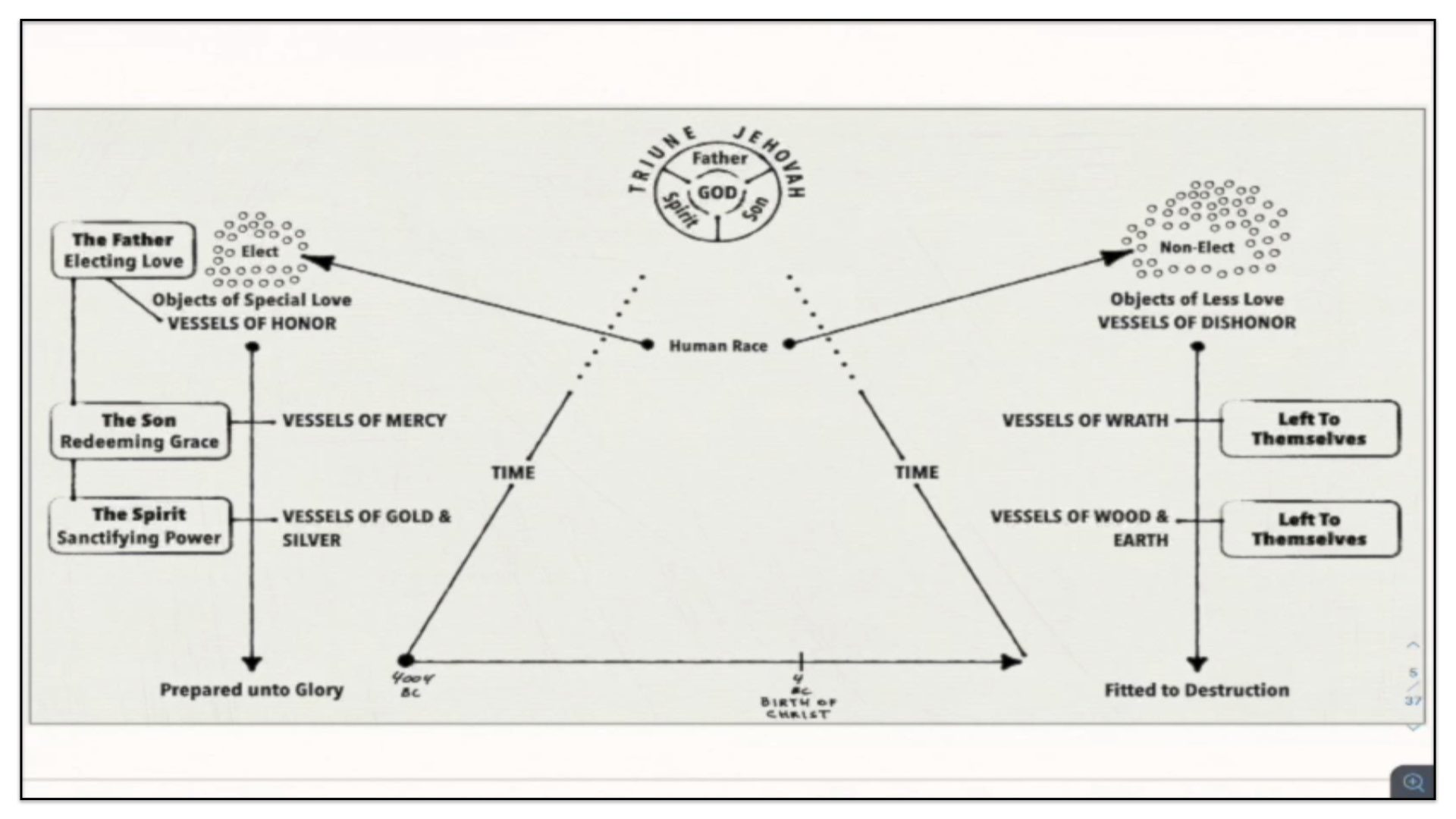
Taking you back up to the Framework of Sovereign Grace, actually take you down to a fresh framework, I’m going to show you two errors that are common with Reformed believers when it comes to the subject of the church and the elect and I’ll be dealing with this subject in more detail next week. I know I was supposed to finish this series on the biblical covenants, but listen, I can only go as fast as I can get out the teachings I have to finish for you and I’m not yet done with the series. So I’ll ask for your patience and trust it to the Lord that it will continue to be a blessing. Watch. I’m just gonna highlight the two errors and I’ll pick up on these errors next week and give a proper response to them. The errors are these.
The Term Church Is Used As A Synonymous Word For All Of God’s Elect People Universally Throughout The Ages
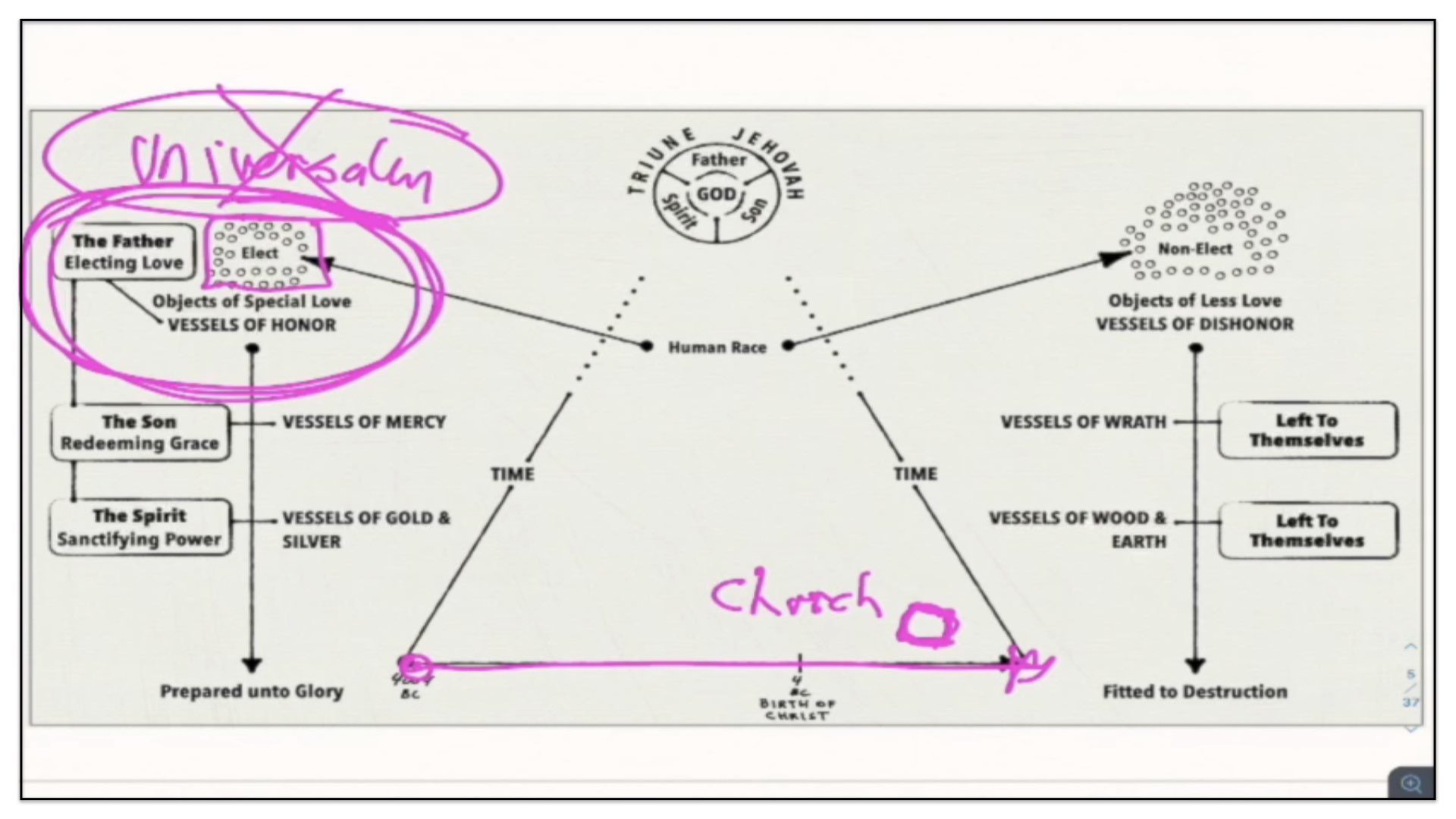
There are some who use the term church as a synonymous word for all of God’s elect people universally throughout the ages. So they’ll talk about the church as if they’re talking about the elect at large. They’ll say, for Christ so loved His church. They’re not talking about a particular congregation on earth, they’re talking about the elect as a whole—for Christ so loved His church, the elect as a whole—without referring to a particular assembly.
Now you see, I don’t believe that the word church should ever be used in a universal context. I know there’s some scriptures that refer to it in a context similar to that, but I’ll explain to you what I believe the scriptures mean next week. I just want you to know now, I don’t believe that it should ever be used within a universal context. It should always be used within a local visible context as I pointed out previously in this concept of a local church.
The Term Church Is Understood To Mean In The New Testament What The Word Israel Means In The Old Testament
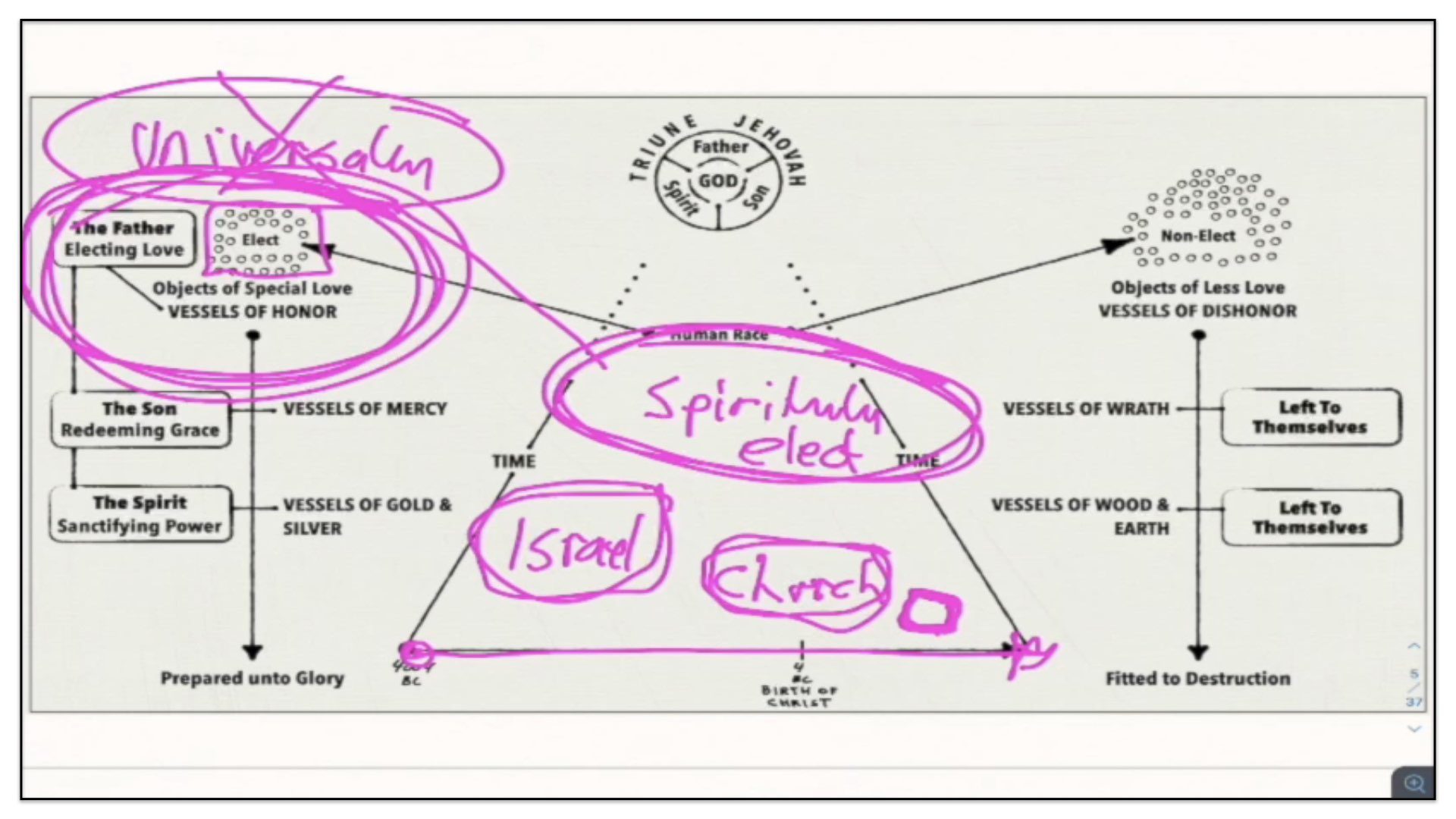
Now here’s a second error that’s often made. Reformed believers will often say the church of the New Testament is the same as Israel of the Old Testament. Now you see what they mean by that. They mean God has one spiritually elect people. Here, one spiritually elect people. And because the Dispensationalists want to say that God has two spiritually elect people, Israel and the church, the Reformed believers—they’re well-intentioned, but they’ve made a mistake on how they’ve gone about to explain the issue—they want to do away with the distinction between Israel and the church is made by the Dispensationalists and in attempt to show that there’s only one spiritually elect people. And that’s a mistake.
How can the church of the New Testament which was organized by Christ during His earthly ministry, the requirements of which are baptism and covenanted together to follow the commands of Christ, how can a church have existed prior to the earthly ministry of Christ before He organized the first church? It couldn’t. And you see, the problem is those that want to make Israel and the church the same, it’s because they carry on this idea of a universal church, which they assume refers to all of God’s elect, which they then use labels such as Israel and the church to mean all the same thing. And how confusing this is! Reformed teachings, some very old works and newer works, they’re a great blessing. But you have to cipher through the confusions of their language in order to truly be blessed by those teachings. We understand what they mean, what they’re trying to convey, with which we agree. But how they go about conveying these things only confuses the issue. Israel and the church are not one and the same. They’re different names and different entities. And neither should Israel or the church be used as a universal term for all of God’s elect people.
A Final Word

Alright. Well, those are the errors that I will be responding to for our teachings next week. Before I close, allow me to press upon you one simple challenge and it’s this. My dear friend, are you a regenerate sinner? If so, are you worshiping the Lord and being built up in your most holy faith through family worship throughout the week? I’m not saying you have to meet with your family every day of the week, although that would be good. But at least several times in the week, do you set apart special time with your family even as some are not Christians? To invite them to join you in a circle and to pray together and to sing some hymns together and to read a scripture and to bring out a little devotion from the Word of God that your soul might be edified? Oh, if you’re not doing that you’re making a mistake. The family unit is God’s first divinely appointed religious institution and it continues to this day. And you should be observing family worship if you have opportunity to do so.
But let me give you one final challenge. Are you a regenerate sinner? If so, have you covenanted with a local church? That is, after being born again, have you found a local assembly of God’s people? Have you been baptized upon the profession of your faith? Have you agreed or covenanted or contracted with those other baptized believers to follow the commands of Christ? If not, you’re missing the blessings of the Lord. Christ has ordained and designed His assembly to be of service to you and for you to be a servant of Christ through it. You’re missing great blessings if you have not joined a local assembly of Christ’s people. And so I call upon you, if you’re born again, but you’ve never joined a local church, go find one of like faith and practice. Be baptized. Covenant with those other members of the church. Share their burdens as they share your burdens. Rejoice when they rejoice. Cry when they cry. Laugh when they laugh. And then seek to be built up together with them in your most holy faith. And above all to honor and glorify and magnify and praise the Triune Jehovah.
Ah, may the Lord grant you that blessing to conduct family worship and church worship, throughout the course of your pilgrimage on this earth. Well, until we meet again next week, I’d like to wish upon you the blessings of the Lord.
Jared Smith served twenty years as pastor of a Strict and Particular Baptist church in Kensington (London, England). He now serves as an Evangelist in the Philippines, preaching the gospel, organizing churches and training gospel preachers.
Jared Smith's Online Worship Services
Jared Smith's Sermons
Jared Smith on the Gospel Message
Jared Smith on the Biblical Covenants
Jared Smith on the Gospel Law
Jared Smith on Bible Doctrine
Jared Smith on Bible Reading
Jared Smith's Hymn Studies
Jared Smith on Eldership
Jared Smith's Studies In Genesis
Jared Smith's Studies in Romans
Jared Smith on Various Issues
Jared Smith, Covenant Baptist Church, Philippines
Jared Smith's Maternal Ancestry (Complete)




